-
Posts
1,999 -
Joined
-
Last visited
Content Type
Profiles
Forums
Store
Help Articles
Posts posted by Peter Green
-
-
The peanut butter I can sort of deal with.
It's the image of the balloons that's weirding me out now!
I have seen this on TV. It's absolutely true. Just check out the home shopping channel.
The balloon is blue.
Oh, great. Now I have this image of The Tick (from the cartoons).
(I promise I'll get Korea wrapped up soon. We've just got some people in from out of town this couple of days, and I've been cooking).
-
......she described a very interesting infomercial in Korea that showed just how effective the toilets were at relieving constipation, and how well they clean peanut butter from balloons! (you can imagine what the peanut butter was supposed to be!)
On that happy note, back to food!

The peanut butter I can sort of deal with.
It's the image of the balloons that's weirding me out now!
-
This is going to be goooooood............

-
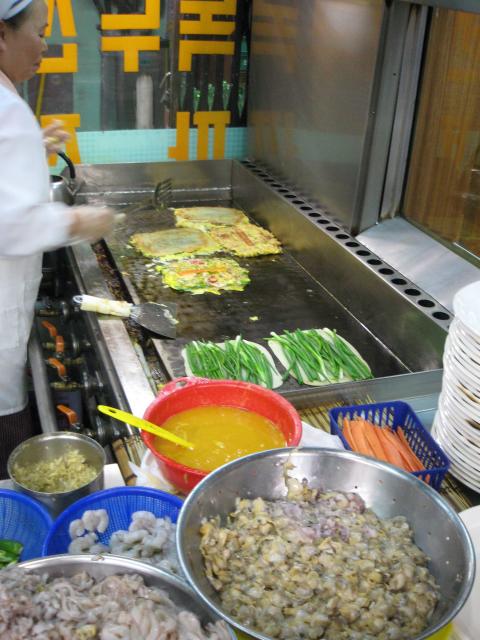
Yoonhi caught this. I should be more careful in my reviews before I post.
I should also lose weight.
You can guess the odds (and I lost the last bet).
It's the shot of the woman cooking the pacheon in the restaurant. She's got her own station just to the right of the entrance as you come in.
-
October 21 – Downtown (break out your orange robes and Patsy Kline albums)
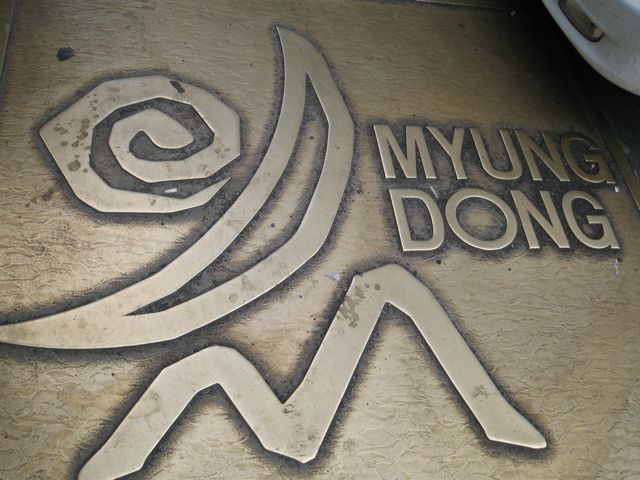
We were back across the river. Myung Dong this time, and we were looking for bibimbap.
Myung Dong has always been the fashionable strip. When we were here before, it was the expensive, trendy place to be seen shopping. A certain amount of that trendiness has migrated to Apgujeong in Gangnam, but there seems to be enough to go around.
From the station, we had a good view down the street as it slopes away.
Jason nudged me.
“It’s a sea of black hair.”
The street was packed, and this was a Monday. And, yes, it was all black. Korea, for all of its hipness, is still deeply conservative in a lot of ways. I didn’t see any pink, purple, puce, or puke coloured hair-stylings. T
Tatoos, for instance, are illegal (I was told). Okay, you can get them outside of the country, but not in Seoul, at least not above ground.
Jason did think part of this may be old rules against gang-style marking, as the Japanese yakuza do. I don’t know how much of it is a statement against body-art, as I did see a couple of piercing studios (but nobody sporting any hardware in their eyebrows or tongues).
Yoonhi remembers on her propaganda trip back in the 70’s though, that some of the boys with long hair on the tour ended up with buzz cuts, and some of the girls that were dress North American style were actually spat upon, and in some cases grabbed, as it was assumed they were ‘working’.
Okay, the girls are dressed better now.
So here we were, in the thick of the walking zone. A nice thing about Myeong Dong is that they’ve cordoned it off from traffic, so you don’t have to worry about becoming road pizza.
The traffic there was, was food.
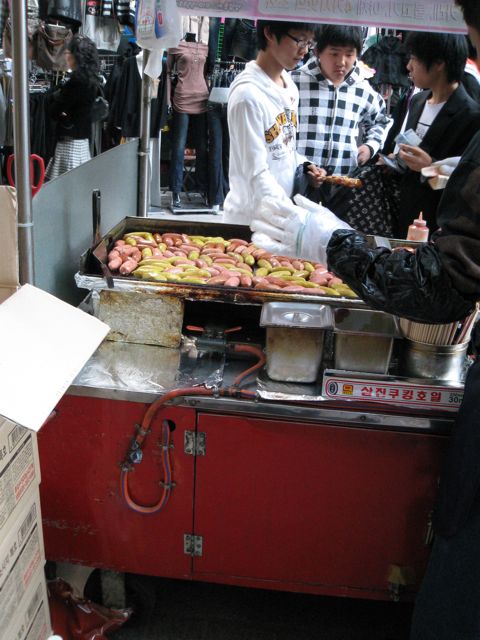
Serena wanted some sausage, so we bought her a trio on a stick. The first two were fine for her, but the third, the yellow one, was a curry wurst, and it had her panting and hooting.
That was a lot of fun to watch.

Yoonhi went for the hoddeok. Nice little sweet cakes of brown sugar.
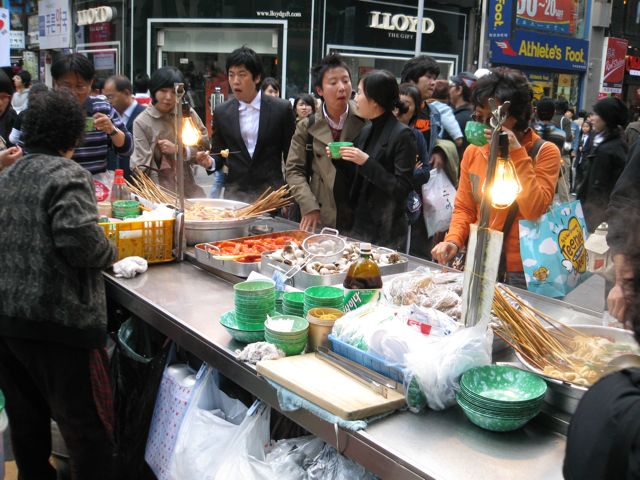
And there were pots and post of odaeng (fish cake) on sticks in boiling pots, ddeokboggi simmering in trenches of orange-red, and sundae, kept hygienically under old plastic sheets.
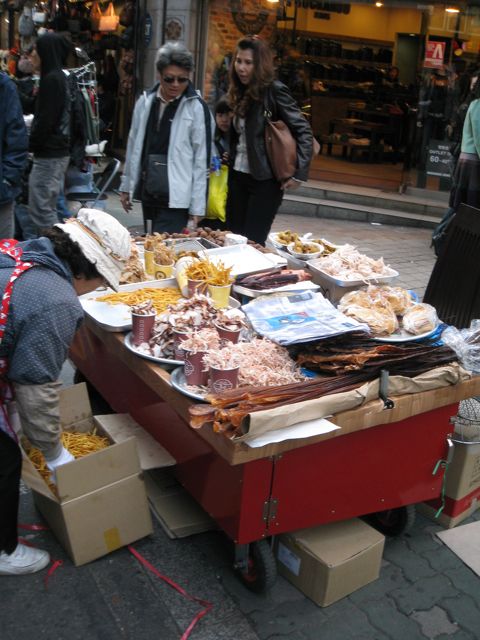
The evil yams that look like shoestring potatoes were lurking out there. I tried to convince Serena that these ones really were shoestrings, but she’s less trusting than Scud. Along with the faux fries, this woman was doing a good business in shredded and chipped octopus and dried fish. And those long, dried tentacles. I should’ve bought one of those to bring back here for the office.

In the midst of all this rampant capitalism, Jason dragged us down a narrow passageway.
There’d been a lot of places on this trip where we’d flat out questioned “how the h*** did you ever find this place?”
In this case, the answer was multi-fold.
First, it used to actually be street front, but the shops on either side had extended out. At night this place puts a guy with a sign (in hiragana and kanji) out on the pavement to direct traffic in (no competition for the parking girls).
Second, it’s in the Japanese guide books for Seoul. This place was discovered by the Japanese, and rose to fame on their reviews.
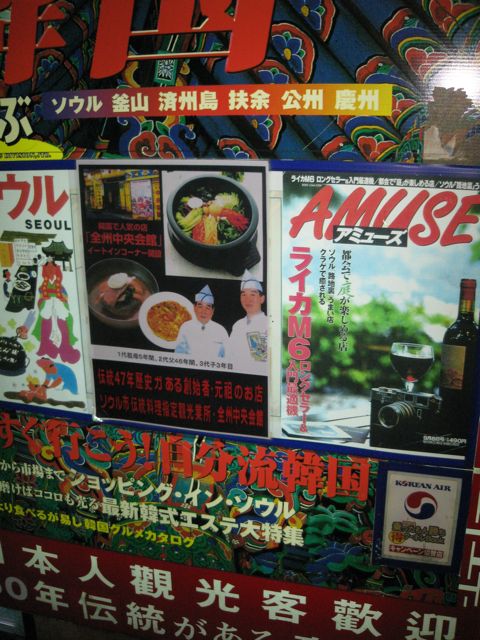
Third, Jason had been dating a girl a few years ago who worked down here for a Japanese firm.
If it’s a good story, it’ll always have romance and food.
The claim to fame here is actually the pacheon.
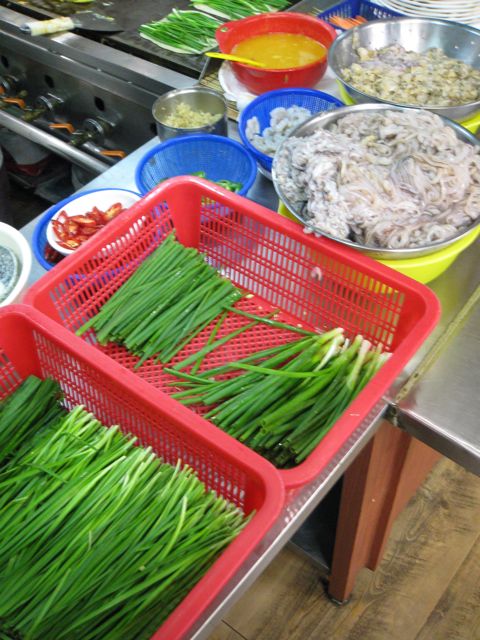
Layers of batter, spring onion, chives, squid, and oysters (plus chilis and lots of other bits and pieces).
.egullet.org/uploads/1194660340/gallery_22892_5262_417976.jpg
We were here for the bibimbap, but damned if I wasn’t going to have some pacheon.
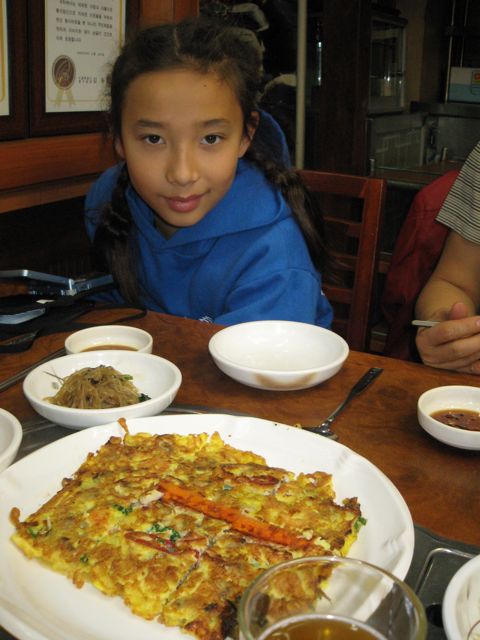
It was good. Crispy batter, stringy spring onion, but with that juicy wet layer of seafood in there. They’d cut it up into pieces, but they were still big. That wasn’t stopping me; I wadded them up and dredged them in the vinegar and soy.
Panchan was a little different. They had chabchae (cold mung bean noodles), which isn’t something we normally associate with panchan. Yoonhi always thinks of it as ‘festive food’, which means someone’s getting married so she and her mom would have to make enough to feed five hundred.

The bibimbap was very nice. About fourteen different ingredients, including tobikos, mu saeng che (marinated Korean radish), raw mu, chrysanthemum leaves, spinach, there was some gosari in there (bracken fern), lettuce, cabbage, gim (nori), egg yolk, and, in my case, raw beef (yukke). I used some of the beef up in the bibimbap, but held enough on the side to satisfy my bloodier appetites.
And plenty of jojang (seasoned gochujang) to make certain everything ends up red.
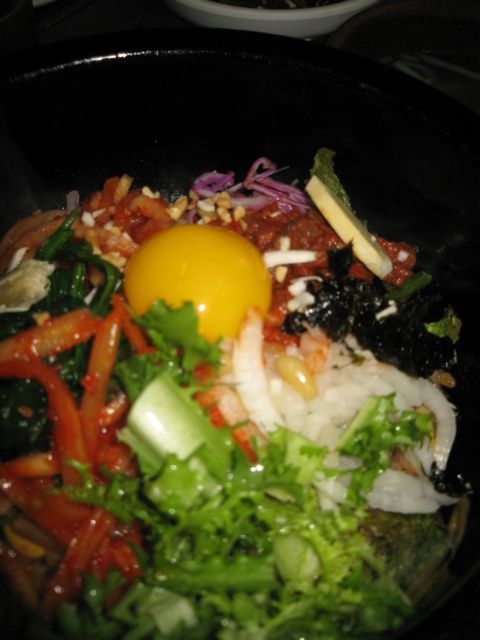
Yoonhi and Jason ordered the “special”, the everything-bibimbap. It was good, but it didn’t have raw meat (so I win).
I should also mention that this was sizzling bibimbap. It served in a hot stone pot that crisps the rice inside, and heats everything through.
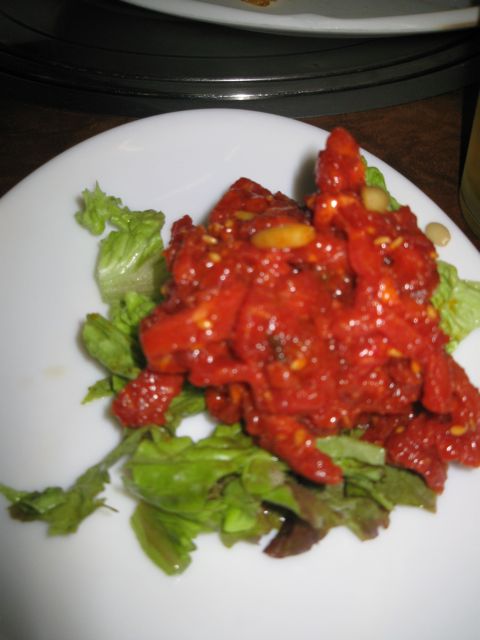
The meat was juicy, cold and crisp, and laced with pine nuts. It was also unfocussed (I have no idea, I swear).
The other highlight of the place was the trip up the staircase to the bathroom. The staircase was a thrill. Battleship stairs, with a rope to steady yourself on the incline (and a passage just wide enough for me).
And once you arrived at the facilities (common area, but separate stalls for men and women) you really knew this place was on the Japanese circuit.
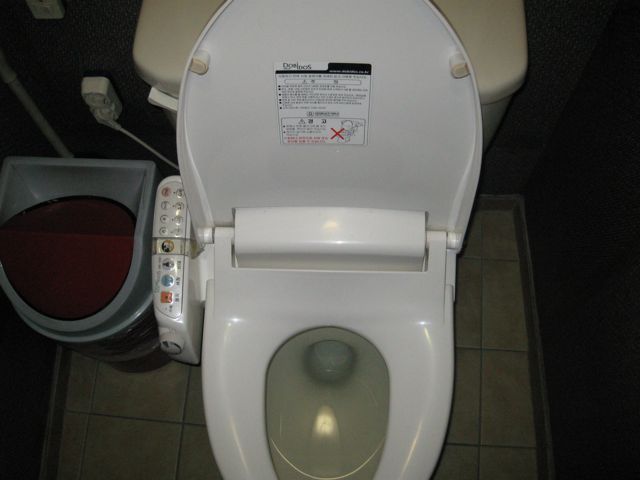
The toilet had a control panel.
This was great! The seat was warmed, and there was a self-cleaning control. I was a little scared to try out too many of the buttons, though. I’d seen what those robots at the expo were capable of doing in terms of scouring.
Next: The Greens Eat More
-
So many choices. Really, you need a bar for each mood.
Let's try one:
- competent bar staff, and this means knowing their products, and being able to recommend things I might not elsewise try. (Yukari's shochu place on soi 33 in Bangkok is a good example).
- educated bar staff. If I'm in the mood, I like a bartender who is up on current affairs, and fairly literate.
- soft lighting. Not too dark. Not too abattoir bright.
- music that doesn't intrude, but fills the background.
- a staff/customer ratio that ensures you have the amount of time you want from the staff, but they're not so bored that you're in the way of them reading a paper.
- air conditioning (if we're in the tropics)
- heating, if we're up north (fireplaces are good)
- decent food, if the munchies are upon me. But not big meal stuff. I don't want to be in a restaurant.
- local small brewery beers on tap.
That's a start. I could write in a place like that.
-
I been to Costco, Peter. There was no kimchi for the hotdogs, only chopped onions, and the condiment pump station (mustard, mayo and ketsup).
I lose the bet!
Not even gochujang in the ketsup pump? Serena got really caught out once when she gave the big red bottle on the table a squeeze.

Can you bring your own? (Yoonhi's family always travelled around Vancouver with assorted condiments in their purses - kim chi, gochujang....)
-
Did you happen to notice what kind of food they had at the cafeteria? In Japan you can get bulgogi bake (like the chicken bake but with bulgogi), and other things you can't get at Canadian Costcos. And the hot dog here is 100% pork, not beef.
I wonder if you can get a side of kimchi for your hot dog, instead of sauerkraut. That would be nice.
Yes, they did have the Bulgogi Bake. I remember Jason pointing it out on a large sign on the wall and saying good things about it.
We didn't stop inside the cafeteria (we were running late for the kobchang restaurant) but I'd bet even money you can get a side of kim chi with the 'dog.
This is Korea, after all.
-
October 20 – Part 4 – Costco
We were driving back from the market, and it struck me that we had yet to do Costco.
Costco is where most of the South of the River types do their shopping. It’s massive, it has lots of parking, and it’s not expensive.
I kind of wonder, as well, if it’s a bit of Vancouver (or rather Burnaby, as that’s the Costco outlet that deals with the Koreans up the Valley) for folks. There are so many Koreans that have done some time in the Lower Mainland now that you start catching echos of Port Coquitlam around Seoul, in particular in Gangnam, the more affluent (middle class, that is) part of the city.
That affluence is a two-edged sword. In part, many of the well-to-do moved south of the river some time ago to get out of the warren of older Seoul. Plus there’s the urban myth (maybe) that all the bridges are rigged with charges to blow when the North Koreans come south, and you don’t want to be on the same side of the river as them.
But a lot of the “money” on the south also came from people that lucked out by being on the right farms at the right time. There were a lot of instant millionaires created when projects like Coex Mall and others started rising from the rice fields.
Even now, the property speculation business is stronger here than a lot of other places. They describe the price of an apartment in terms of the value, plus the “speculation”. In many cases this is just people buying apartments as they expect the place to be ripped down at some point and a new, more desireable project to go up, which they will have a share in.
The upshot of all of this is that there’s an interesting mix of people on the South side. Older money, and the nouveau riche ex-rice farming crowd.
This all goes back to the bit we were talking about on architecture. Korea, and especially Seoul, is in the throes of change. When Jason first arrived back in the early 0’s, he was immediately challenged by ugly buildings and Korean bathrooms.
Korean bathrooms are designed to drain well. That’s because they’re going to be wet. There are, and never will be, shower curtains. Everything gets soaked, and everything drains.
This is not conducive to a book shelf.
As an aside, squatters aren’t an issue. Koreans, like the Japanese, have embraced high tech toilets in a big way……as I look at that comment, I’m taken back to the many times I’ve embraced my toilet, but it wasn’t so much an aesthetic values thing……
But the new places are moving to (shades of Vancouver) Western bathrooms. Shower stalls, blocked off from the rest of the room, and non-slippery floors. No more plastic sandals required.
Anyways, I’m drifting off topic again.
We were driving back through this wonderland of opportunity, and, as we weren’t far from Costco, we figured it’d be convenient to see it now, while we were near.
This was a big mistake.
It was Sunday.
We made it to within about three block before everything jammed up. It took us another twenty minutes to get to the turn, and five minutes after that to make the approach to the parking lot.
First, here’s the spiel on Costco in Korea.
Costco opened up here in 1994 under the name of Price Club. Now they’ve got three warehouse stores here in Seoul, one in Daegu, and another in Daejeon.
The competition, although it’s not really competition, is eMart. They do alright as they tend to open 24 hours a day, whereas Costco is 10 to 10. But eMart is more of a proper supermarket, while Costco is, well, Costco.
Second, let’s talk parking.
I was very disappointed with the parking attendants. Costco, icon of modern warehouse shopping, just had guys (and some young ladies) in jeans and reflective safety vests.
I’ve gotta stop here and talk about the parking ladies.
In days gone past, when you went to a department store, there was an insa lady. This was a young, impeccably dressed, coiffed, and detailed lady whose sole function in life was to bow to you when you entered or left the store.
Sometimes I’d walk in and out twenty or thirty times.
Now, that is largely a thing of the past. What we have instead are the parking girls.
You’re going to have to excuse the fact that I’m a guy. I think this is great. They’re often done up in thigh-high plastic boots, skin tight cltothes, and enough make up to plaster the Vatican.
But it’s not just the look, it’s the dance. They do this little kata of rotating their hands in the proper direction, rolling their body, and ending with a bobbing bow (an insa).
It made me want to run out and buy a car.
Anyways, the parking staff were herding us up past the first, second, third,….all the way to the roof. Jason was adamant.
“I’m not parking on the roof.”
Sure enough, he was right. Once we’d begun the long descent, we found plenty of parking on the lower levels. This is important, as you only gain access to Costco from the lower levels.
Yeah, I know, I’m spending too much time on parking. But I just want to put it in perspective as we did spend too much time on parking.
Your initial impression upon entering Costco in Korea is “I’ve been here”. You show your card at the entrance, the same as at home. And there’s the same open area of cheap DVD’s, CD’s, plasma TVs from Korea, computers from Korea and China, and furntiture and clothes from Korea.
(Note – sorry, everyone, but Costco isn’t keen on photography.)
Some of the kitchenware is a little more interesting. Nice little chigae sets in black stoneware and metal that you don’t see in Canada, but otherwise, it was all much the same.
But that was durables. We needed to queue up to take the escalator to the food floor.
Jason and I hit the wine section and stopped moving for a little while.
It was a pretty good selection of Europeans, Australians, Americans, and South Americans. The South Africans were there, but not in any particular depth.
Nearby was the meat counter. Lots of the usual – steaks, roasts, etc – but also lots of bulgogi-ready stuff, LA cut ribs, and thick slabs of bacon for samgyep sal.
As you’d expect, there were mounds of squid and octopus, and more than enough fish to go around. In a separate stall a man in whites was carving away at a whole tuna, a little bigger in size than Serena (and a lot wider).
Lots of kimchi, and lots of ddaenjang and gochujang. Ready to eat Korean snacks were piled up on the shelves.
But there was also plenty of what you expect: big sacks of M&M’s; salad dressings by the litre; coffee beans in kilo sacks (but Jason didn’t have a grinder) and preground in 5 litre cans; cheeses; paper towels; nuts for baking; and the usual assortment of things in really, really big packs.
And there was also the bakery, with the same loaves, muffins and Danish you’d see in Vancouver.
We fought our way through the mob to the checkout counter. Jason had his wines, and really needed to get, at least not at this late stage in the trip.
One other difference we noticed while checking out, there’s a cafeteria, a big sit down section. This goes to support my theory that you must have some form of restaurant within some critical distance in this country.
With traffic being as bad as it was (everyone was coming back into town) we decided to head straight for dinner.
Guts
We were meeting another couple. They’d been in Vancouver in the summer, and had two girls Serena’s age, so it was a chance for Serena to get in some social interaction while we adults enjoyed the night out.
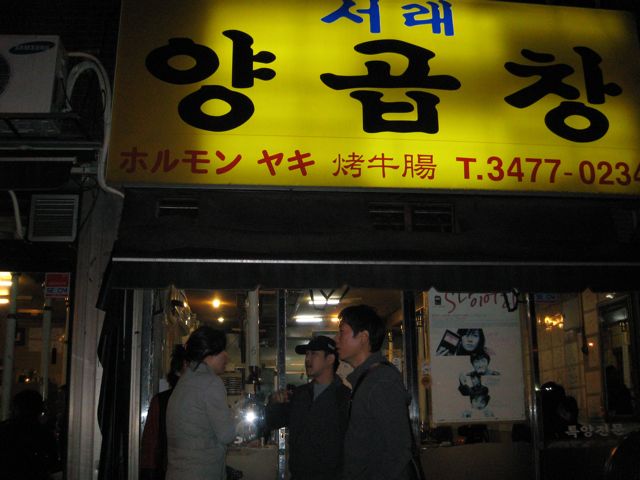
It was a return to kopchang for dinner. This location was over in Banpo, with a sign that proudly announced that they were a yang gopchang specialist.
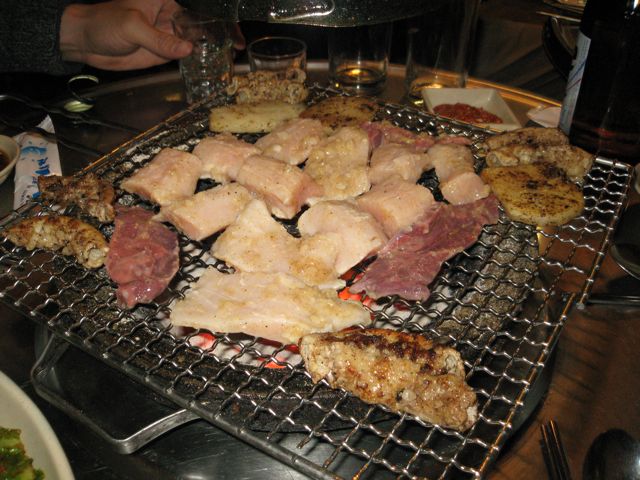
So, in keeping with their advertising, they had some good yang, thick and white and very chewy. Before that, though, we’d started on the gopchang itself, the intestine (the tube).
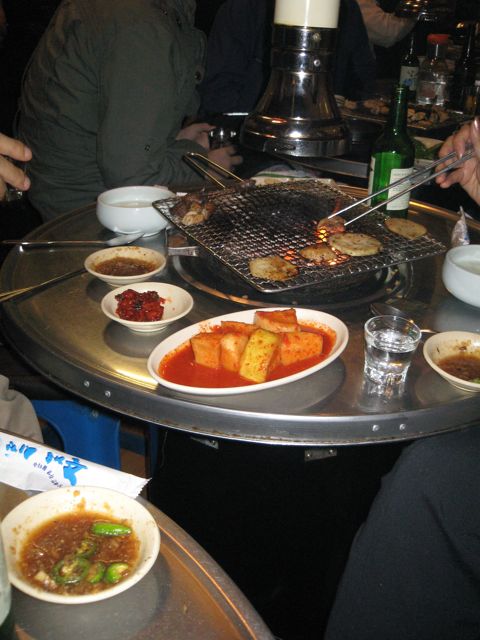
The style here was different from what we’d had over by Jason’s place. It felt wetter, and I’d say that was the marinade. I know it’s harmless, as it would just be remnant marinade in the tubes, but it gave you the feeling that they hadn’t cleaned it out as well.
Still, you have enough soju and things start tasting better.

The ddaenjang chigae was okay, but was lacking a little of the depth of flavour we’d had in some of the other chigaes (Nori People’s kim chi chigae is still a stand out).
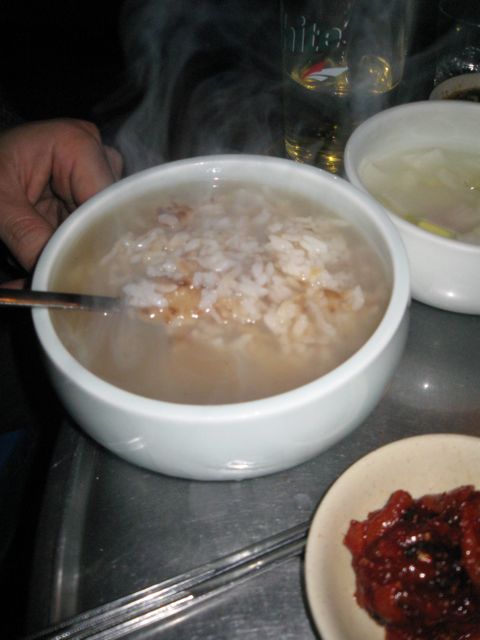
I was still a little full from lunch, so I passed on the next round of food, but the others ordered nurungji. This is the toasted scrapings from the bottom of the rice pot, with water poured over it and then brought back to a boil. This is something that you can’t do with electric rice cookers.
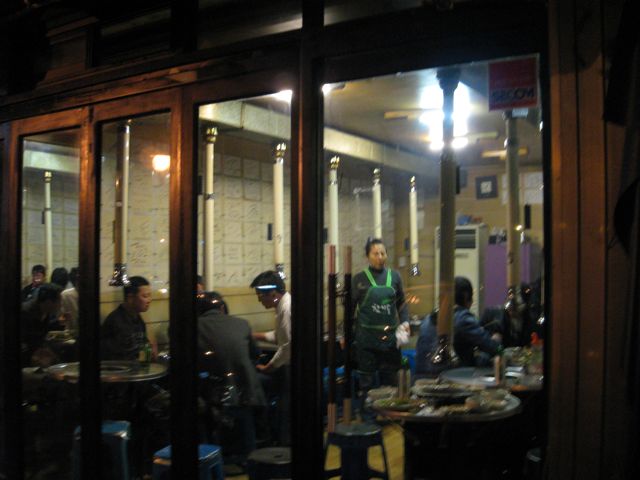
The weather was perfect for this meal. Crisp and cold outside, which made it ever so pleasant to sit around the burners eating hot meat (I use the word “meat” with some liberality here). Soju to clear the grease and warm your core, and company to chat with (although my Korean isn’t up to the task).
After dinner we split up. Jason was heading home to take care of some things, while the four of us were off to see Seoul by night.
First we drove back North, across the Han, making for Dondaemun, the East Gate. From here we drove along Chyeonggyecheon restoration zone until we could find parking, at which point we ditched the car and went for a stroll.

Inaugurated in 2005, this was a major accomplishment for Lee Myung Bak, the mayor of Seoul we’d mentioned back when we were at the beach. The stream wasn’t much more than a sewer back after the war, and had been covered over by an expressway in 1968.
Lee Myung Bak had the road removed, and set about putting in an extensive water filtration and purification scheme to get things to a tolerable state. Along with the technical side, the stream was laid out as a park, reminding me of San Antonio’s RiverWalk, without the shops and cafes (alas).
As with all things, there was more than enough controversy. Some claimed it was just a vanity project, others argued against the influx of gentrification that would accompany such an improvement in a neighborhood. And, as always, there were a lot of apple boxes being delivered around town.
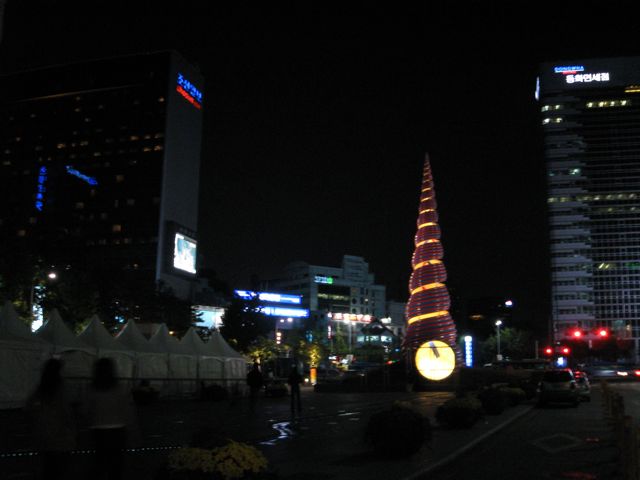
Lit up at night, it made a pleasant walk. We followed the course of the stream West, to it’s starting point at City Plaza, and then backtracked to where we’d parked.
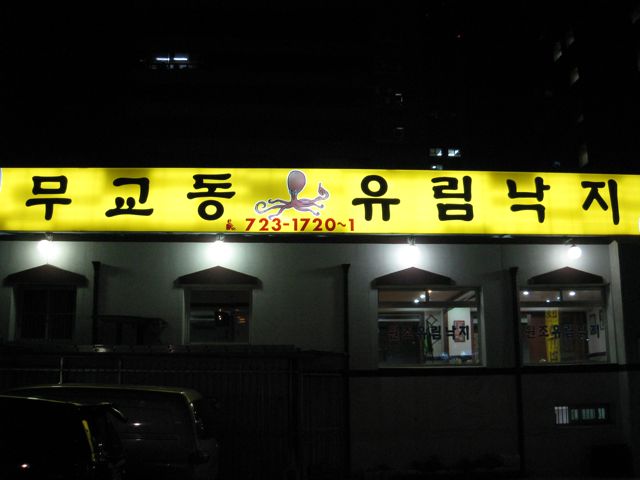
As always, there was plenty of food about. One area seemed to be specializing in octopus dishes, and I wished we’d had more time, as this looked like a good spot for a bite.
Our parking lot, however, was going to lock down at 10, so we needed to be moving.
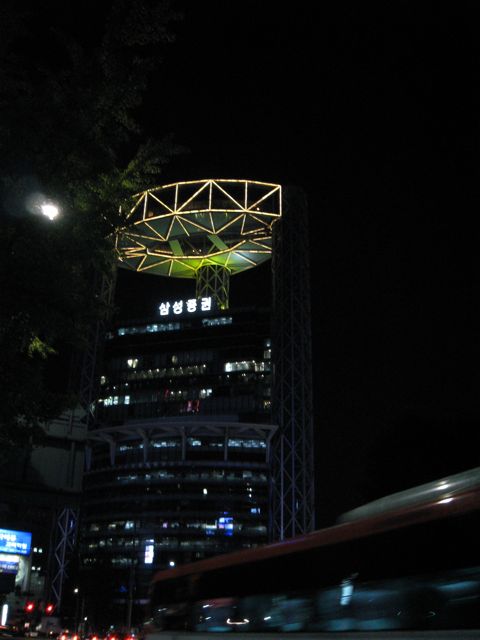
Overhead, another landmark of downtown Seoul is the Dragon’s Eye, the Jongno Tower. Some rail against this as an aberration, and would happily see it disappear, while other look upon it as a symbol of the new times. Whichever side you’re on, at least it gives ou something to navigate by.

We’d parked by another theatre, this one playing “JUMP”. Again, a non-verbal performance stressing acrobatics and the martial arts. The theme of this is that a couple of burglars hit up a Korean home with a fairly violence-prone family.
Interestingly, Dolsilnai has put their stamp on this production, handling the costume design. Dolsinai has been designing new, modern hanbok, the Korean national dress. In the poster notes I looked through, they’d been tasked here with creating traditional style clothing that would be loose and comfortable enough to work in the choreography.
They’re also an active promoter of that ancient Korean textile – hemp. (It’s not just a Vancouver thing).
From Chyeonggyecheon we drove North, past the palace and up the slopes of the hills, taking in the Skyline drive, the city of Seoul laid out below us, all aglitter and off limits for photography.
We stopped at the observatory at the top, and declined the offer of bad coffee for which we would’ve had to line up. The scenery itself was quite pretty (I just didn’t have the guts to buck the security types that were around watching for photos), and if you could brave the cold, it was a spot worth visiting.
We drove down from here, through the old money neighborhoods that fill out the mountainside, with some palatial spots using up significant amounts of real estate. We passed a few sharp looking neighborhood espresso places, but not that much in the way of restaurants (for a change).
Further down we were surprised to find out we could drive past the Blue House. For decades this area had been a restricted zone, but about eight or so years ago it was quietly opened up. But people have grown up with the idea that it’s “off lmits”, and so it came as a bit of a shock when security waved us through into the empty streets.
Obviously, I continued to keep my camcorder and cameras stored away.
I might seem paranoid, but Yoonhi remembers from long ago on her high school tour one kid snapping a photo of a bridge. Security were all over them, knew which seat it was in the bus where the lens had snapped, and weren’t in a mood to discuss the matter.
I have a lot of respect for Korean security.
I think of Seoul as traffic jammed 24 hours a day, but the path we took heading south wound through Namsan and down the back streets behind Itaewon. Narrow curved streets that followed the contours, winding and wending their way, as opposed to the orderly grid of Gangnam (south of the river).
Our hosts were taking us to the night time views. We’d seen the stream, the mountain, and now we were looking to see the river.
Back across the bridge, we did an odd bit of driving through narrow passages and tunnels that took through the levee and into the wide banks of the Han that are all park area.
We saw signs for R8 as we drove, and then the parking attendants were back, directing cars to their spots (no parking girls again, darn!).
Jason was waiting for us here, but it soon became apparent that we’d stumbled upon a private party. We made a half hearted attempt to crash, but it was pretty apparent we weren’t getting in.
But, well prepared, we fell back on Plan B, which just involved driving back up the river a little ways and finding another bar.

These bars are big, semi-permanently moored boats. This one – “On” – was three floors. The bottom deck, which we checked out first, was boothed off with secluded areas looking out onto the river.
However, it was very much a “bottle of Johnny” sort of place, without much in the way of alternatives. And this low, it didn’t have much of a view.
So instead we went upstairs to the café, where we could have some beers (a Hoegaarden for me) and tea (“Forget Me Not” flowers) for the ladies.

Not really memorable, other than that the beers came in their bottles with white paper napkins artfully folded over capping the top like a KKK hood.
We could’ve gone up another flight, but that would’ve been the restaurant, and the idea of Italian in this setting wasn’t too encouraging.
It had been a long day. In fact, it had been a long couple of weeks, and it was catching up to us. We debated another phase, but wisely chose the better part of valour – sleep.
Next: Music to Watch Girls By
-
I was looking searching for Korean cookbooks, and google sent me here to this topic (well second page!) LOL. Reading the forum has gotten me to think about ordering some Korean language Cookbooks. Mainly because a lot of the recipes I am looking for are not written in english, and it is another way for me to practice my ailing Korean language skills.
Can't wait for the next post!

Milg,
Yoonhi's of the same opinion. A lot of the English language books are getting pretty old (Noh's Practical Korean Cooking is 1985), and there's not been much coming on the market of late. But when you go into a bookstore in Seoul, the shelves have lots of cook books in Hangul, so you know the material has to be there.
We've got a number of books that Yoonhi's snagged from her sisters, so we're going to poke about in those.
And now, back to our story.
-
What does "Taisho" mean?
Isn't Taisho "captain", as in a commander of men?
-
It's not just the Chinese that do this, either. A number of my favourite spots in Vancouver have the most intriguing notes plastered on the walls in Korean and Japanese (the Thai places at least don't have a big enough native contingent to support such acts). Even if you read the scripts (or characters) the names can be so euphemistic that you're never going to know what it means.
My recommendation? Ask the waitstaff what it is. Unless they're working flat out, they'll try and help (obviously, peak lunch or dinner hours is not the time to explore).
Better idea, as pointed out, get someone to come with you who can do the asking. Plus you'll have dinner company!
-
October 20 – Part III – Wadeabout
Lunch (and soju) buoying us up, we had a minor act of trauma to undergo in the bathroom, and then we were back out and about, checking out the market.
First, you know I had to do it, I had to find some ge bul.
This is for you, Sheena!
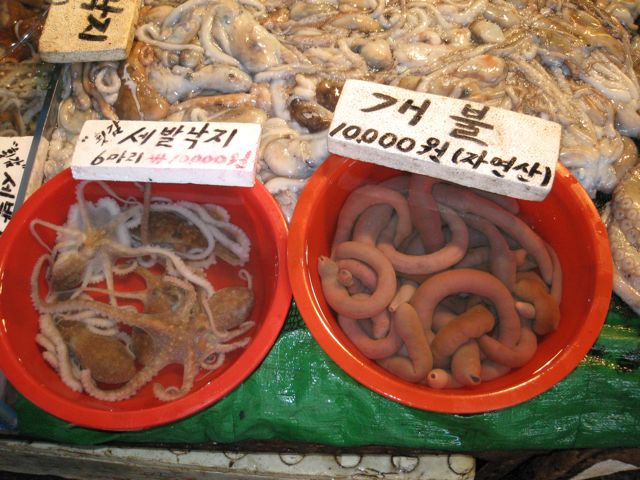
Y’know, I think we need to add “un-circumcised” to that description we’ve had floating around. (Does that mean it’s not kosher?)
And I was really tempted byt the sabbal nakji, the little live octopi in the side bowl…but I was too full to eat one.
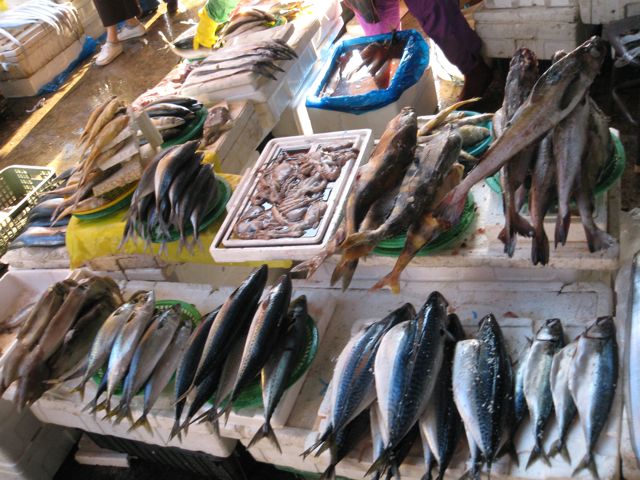
Obviously, there was more than enough fish to go around. There was fish in tanks, fish in tubs, and fish that were just lying out there.
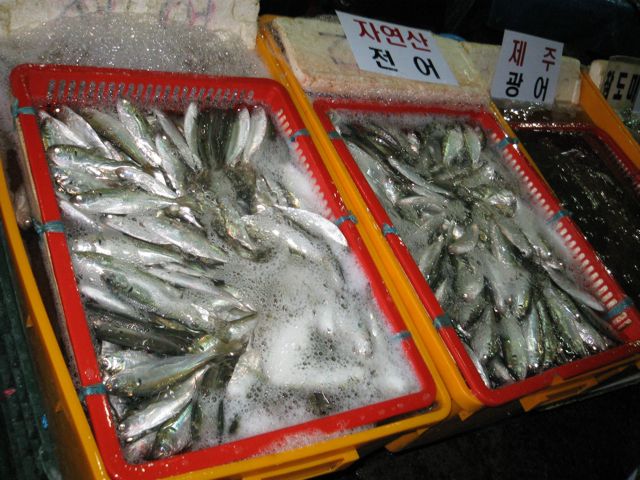
Nothing like a plastic tub with a hose in it to make a fish feel like it’s right back home.
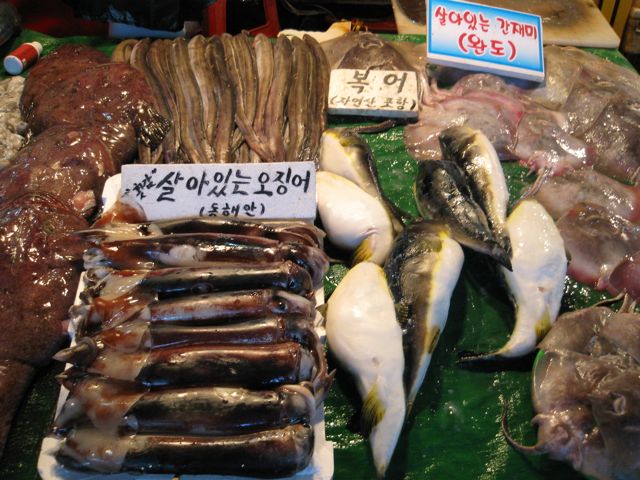
But it’s the odder looking stuff that you’re curious about, and so am I. Those are pogeo – pufferfish – the puffy looking fish things. I’ve had them before, back on our first family trip to Korea in ’92. We had no idea what we were ordering, all we knew is the restaurant had only one thing they’d serve, spread over several courses.
Later, when we returned to meet our friends, they were horrified. Her father had died from a bad pogeo.
Underneath the sign, it says that the pufferfish is wild caught from the city of Pohang.
To the left of Pauly the Pufferfish lie some squid. Nicely tubed up. These are advertised as “sashimi style” to show that they’re fresh, and it’s emphasized that they’re not from China, as everyone in Korea is now paranoid about Chinese products, because of the “quality challenged” nature of Chinese products.
And beside that are some skate, skinned like something from a Hannibal Lecter film. This is from HwangDo.

We found some silver eel from Cheju…or is it just "Cheju eel"? We're stuck on this.
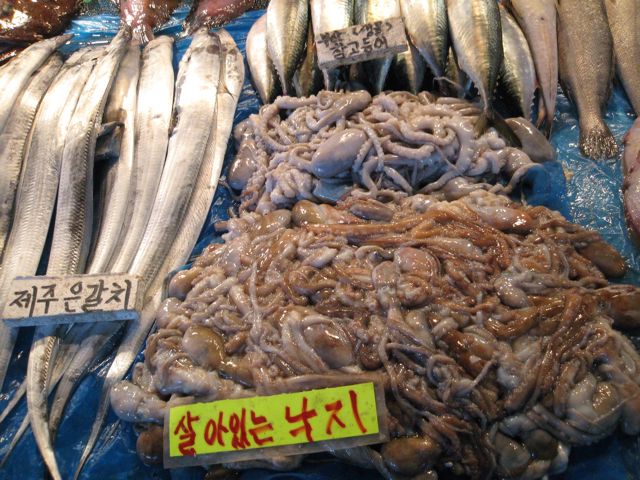
We figure it’s “silver eel” – ungalchi. But hey, pay no attention to our mistakes! Look over to the right and we’ve got piles of octopi! (Do octopi get piles?)

Regardless of the state of their hemorrhoids, some of these guys just want out of their tanks.

There were lots of our old friends from the East Sea. There were the things that looked like mussels, but were bigger than my hand. The Koreans called these “clams” – jogae – and the meat was nothing like a mussel. Now, there was a bucket of shelled mussels right behind them, and to the side were, as my expert reference says “you know, those curly conch thingies”. If they were smaller, they’d be golpengi, but these are way to big to be those. These are called sora. That means snail, but these are pretty much Ed Wood sized snails.
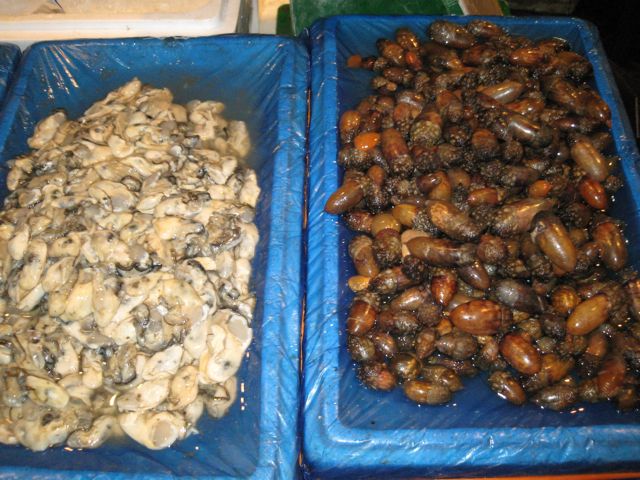
There were plastic lined tubs of shucked oysters for using with pancakes (cheon), or for just eating raw. You don’t see it in soups very much (as opposed to clams). And beside the oysters there was a thing of things. They looked kind of like deep-water acorns, or maybe a smaller version of mongke.
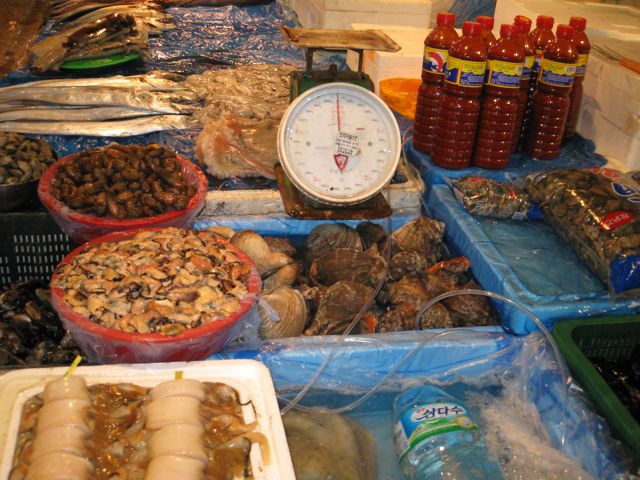
And, of course, they’re acres and acres of just, well,…..stuff. Shells, crawly things, sauces, and dead things from the sea....it all makes me yearn for low tide.
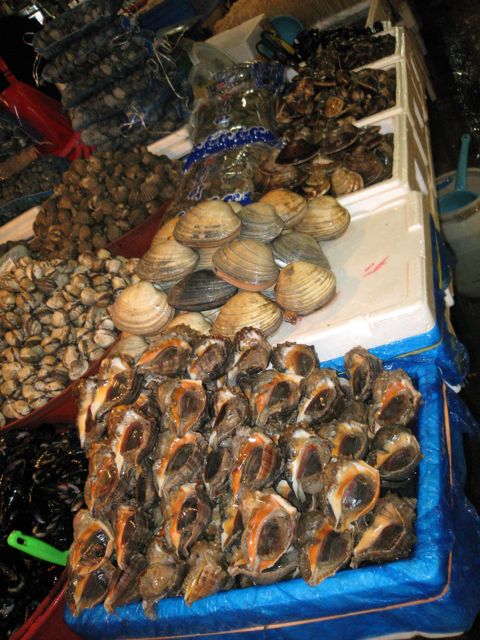

And more octopi. Plenty of nakji, and beautiful, beautiful munau, just perfect for blanching and eating with gochujang (like we did for lunch, but these were way bigger!).
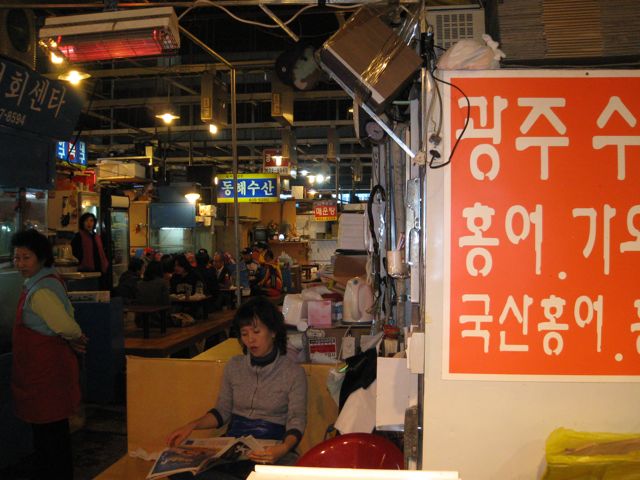
Disappointingly, we found the error of our ways. We shouldn’t have hiked over to the restaurant to eat our meal in comfort. We should’ve wormed out way into the dark belly of the market where they had a “you tell us and we’ll cook it” set of platforms. This is where you want to be at 2 a.m., with your weight in soju bottles on the table in front of you, and guys with sharp knives running around the place (hopefully some of them are fishmongers).
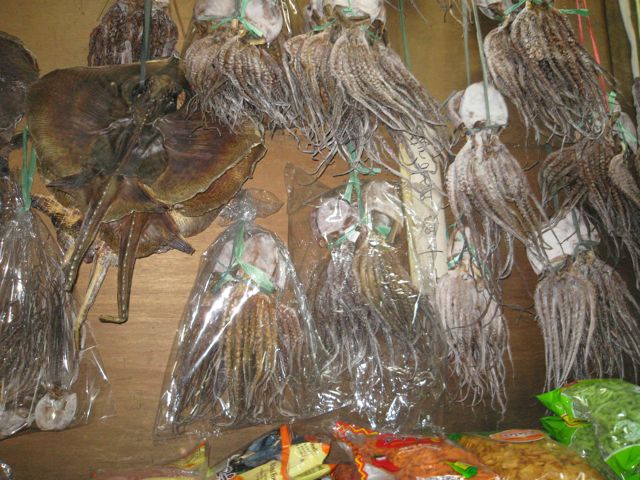
After we’d finished with the wet side, we moved to the dry.
I’ve said it before, I’ll say it again…..Korea eats a lot of dried seafood.
There were piles and piles of the stuff. One shop had it four feet deep.
As we walked through here, people would race up to us, but then turn dejectedly away. Yoonhi and Jason overheard their mumbled “oh, it’s just tourists again”.
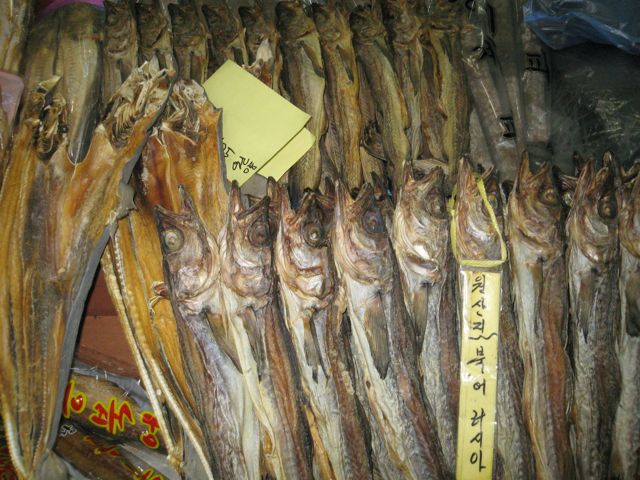
But, we did end up buying some stuff. I picked up a 2 kg bag of dried octopus, and another big bag of dried mussels, and dried squid.
I did not, however, buy the cubic meter of bar nuts.
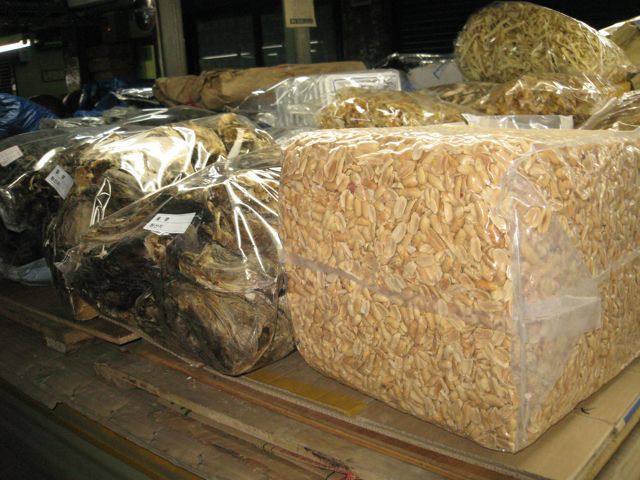
And if you were ever interested in buying kelp (miyok) by the square meter

this was definitely the place.
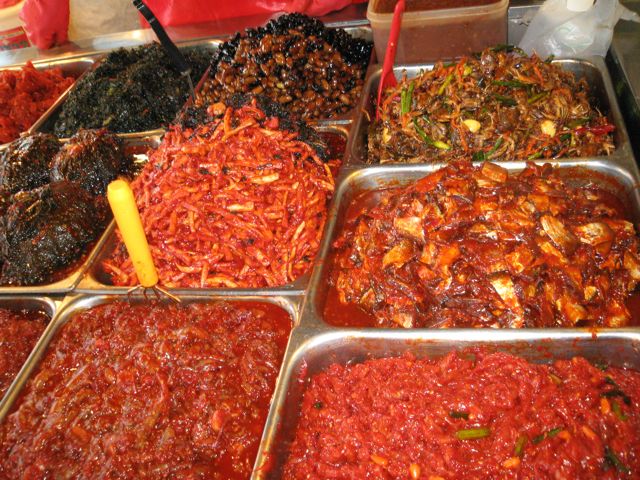
What would a Korean market be without panchan? It’d be like a Thai market without piles of curry paste! Or a Canadian market without windchimes and crystals!
There were piles (everything comes in piles) of squid and fish, and more stuff. There were clams, fish eggs, fish guts, and more and more.

And they had plenty of those marinated crabs. Not as big as the ones I really like, but good and solid and crunchy.
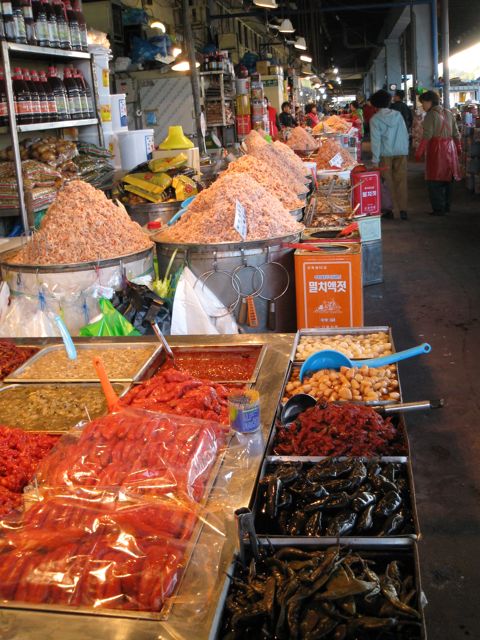
Beyond piles, there were mounds. This is the language of markets. Big, pink mounds of shrimp fry, a key ingredient for good kimchi.
Ah, to wake up in the morning to the smell of fermenting shrimp!
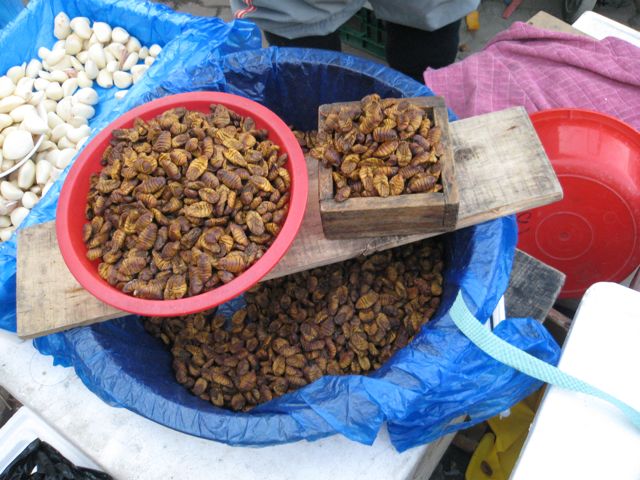
And, finally, if I ever really need to fill up my bundaeggi cart some day, I now know where to go. In their dry, unboiled state, their only mildly disgusting, and the smell is nowhere near as nauseating. If anything, they look as innocuous as a toenail that’s been ripped up, died, and torn off of someone’s foot.
I must really try some at some point.
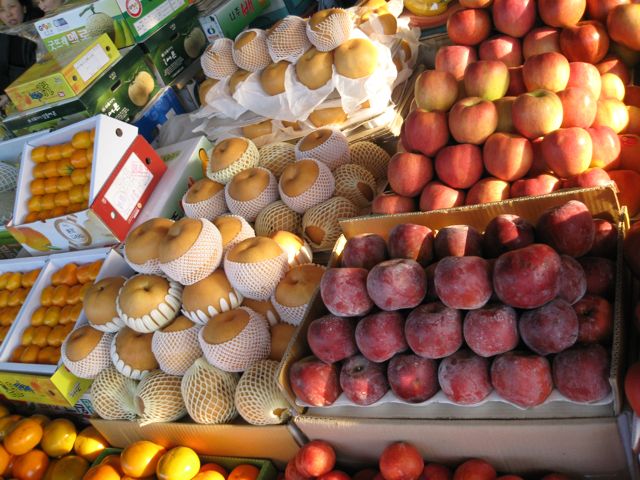
We never got back to to the meat market, but dead animals often look all the same. We did stop at the produce to stock up on more pears, however.
How could we not.
As we were walking back to the car (we did have a dinner appointment to keep) we came across one of Sheena’s requests, bungeobang (literally “goldfish bread”).
I’ve put the pictures up before, but I should put it in context here.
When Sheena had talked about fish stuffed with sweet bean, I was thinking about real fish. So were Jason and Yoonhi. But as soon as those to saw this, they immediately knew what she meant.
The lady running the stand was quite shy, especially once one of her friends said “You’re going to be on food TV!” at the sight of my camera.
She cried “I’m just new at this!”, but we told her it was okay, so was I.
The kit is really ornate. Seven separate waffle griddles over a gas burner, each lovingly detailed with a goldfish mold.
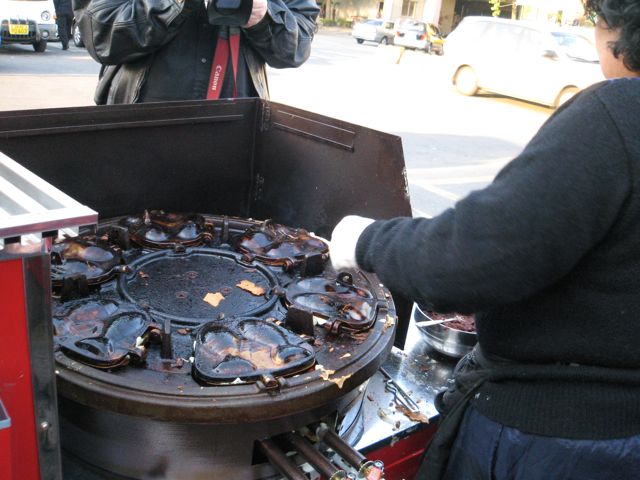
It looks black and abused on the outside, but when you pop it open you get a shiny brass mold of a goldfish.
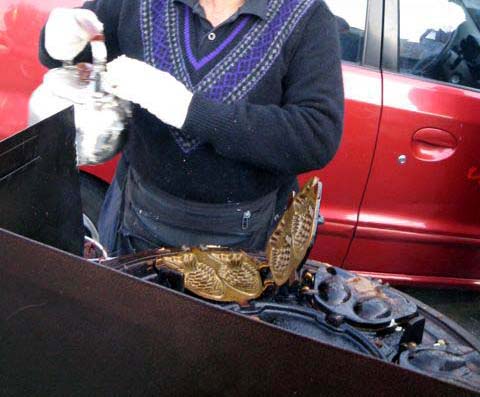
She keeps the batter ready in a teapot, the sort we use for keeping boricha (barley tea) around the house, and pours from this into the double fish mold.
One of the double goldfish orders was up on the for sale section, but we’d been bush filming the making of the fresh one. Some older guy popped out of nowhere, dropped some money, and gleefully made off with them. Then we heard him cursing “damn, it’s cold!”

These are things you need to eat hot. It’s like indulging in a napalm stuffed waffle. We bought four, and ate them in the car.
From here, we needed to visit one of the big tourist draws of Korea.
Next: Costco
P.S. - from the lunch, the abalone was still squirming after it was cut.
-
While I think your mission to stomp out pomposity in food writing is admirable
Food writing without pomposity?
-
Lunch In The Hanger
We followed the guy with the food at a light trot. Sure enough, I would get left behind, my greater bulk unable to negotiate some of the tighter squeezes between the hagglers intent on getting their fish.
But Jason or Yoonhi would hold back and keep an eye for Serena and I, and soon enough we had cut through the fish hall, across the parking lot, and then upstairs above the beef hall. Then there was a long hike up to the second floor and an extremely non-descript door.
The result? A non-descript restaurant. But what do you need? Low tables, cushions, a cooler full of soju, and a shelf for the shoes. The place was about ¾ full, with one corner table hosting a crowd of around 10 guys and 50 soju bottles.
It works for me.

For a change we’ve got some gaejya (Korean mustard) to go with our dishes. Not that we’re shorting ourselves on chilies, garlic and gochujang.
First up was a treat I’d insisted on. Fresh abalone.
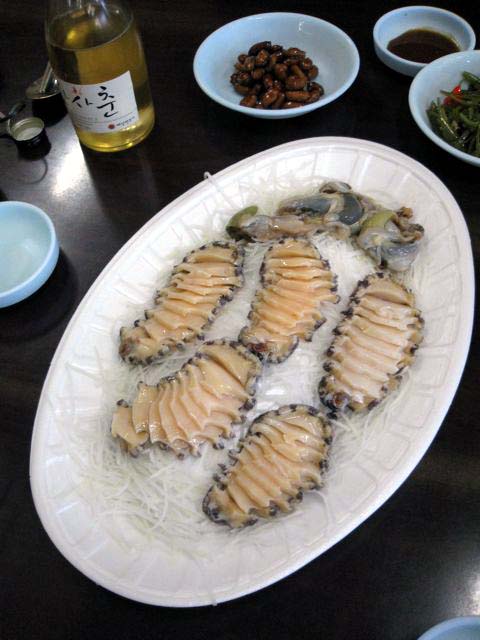
I guess it’s my Vancouver upbringing, cruising the beaches and collecting shellfish, but I’m a sucker for anything with a hard carapace on it. This was just right, that crunch on your teeth as you masticate through the tougher rilled periphery, and then the pleasing fleshiness of the main body.
I tried the “other bits” the squishy stuff that hangs around in the shell. It was mildly repulsive, but in a good way. I tried to get the others to try some, but with no success.
If Scud was there, I could’ve talked him into eating some.
We had this with an opening bottle of sansachun, that nice, light fruity wine we’d had before.
But perhaps I was growing hardened to such lighter delights (or maybe it was just my kidneys that were hardening?). We finished this bottle, then switched to soju. It was a far better match to the cool cleanliness of the shellfish.

We’d also brought back clams, and had these lightly steamed to open, at which point we were upon them like Huns through the gates. I salivate openly at the thought of fresh, buttery clams. And at this size, the texture works just right, not so large that you become organ-conscious, nor too small to be worried that you got something the cat spit up.
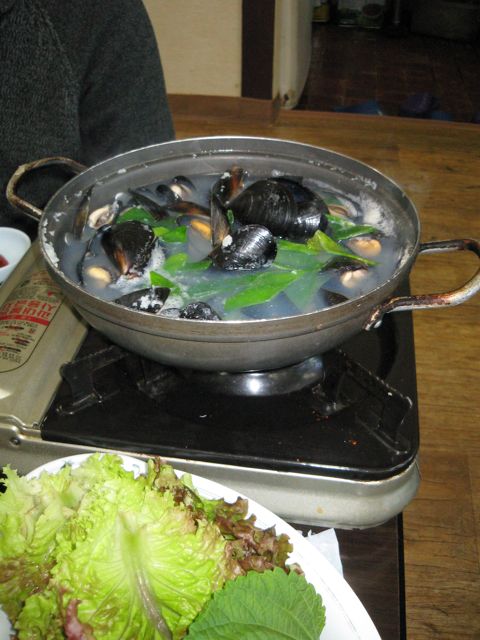
And mussels in a bath teaming with garlic, onion, and other goodness. How can a normal human not be overwhelmed with happiness at the sight of a big bowl of moules?

I’m gushing, I know. But when I look back upon these pictures, I feel very, very happy. The octopus was a thing of beauty. Soft and chewy, like really good marinated octopus you’d buy in Greece to go with a bottle of Retsina on the plaka. Nothing tough or dry about this, it gave like those old rubber bands you’d chew on during grade 8.
I have a soft spot for octopus. When I was quite young, my parents took me to the venerable 7 Seas floating restaurant in North Vancouver. There, while my brothers were having fish and chips, I discovered cold octopus. I ate as much as I could, and then hid a couple of pieces in my pockets to take back for my best friend, who was Canadian-Japanese.
Yoonhi remembers going there with her family at some point, too. They weren’t as impressed as I was, but they at least had the good sense to bring a bottle of gochujang with them. Never leave home without a bottle of gochujang.
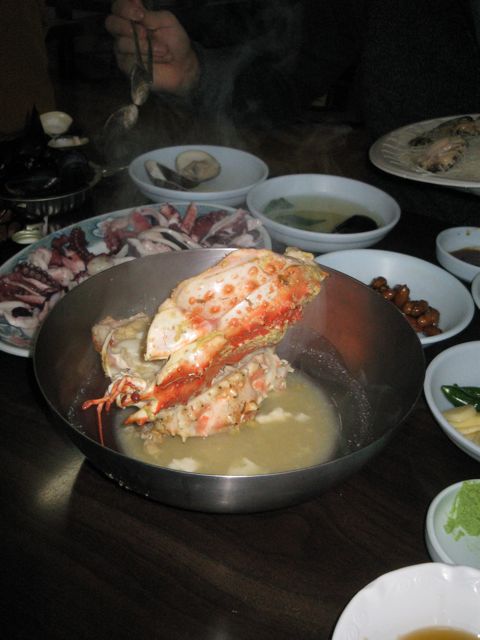
More king crab was the main treat. The legs were broken at the table next too us, cracked, and then placed before us to be savaged. Sweeet, clean meat. The only problem with crab is, at some unknown spot, you’ll hit a wall and have to stop. I figure it’s akin to altitude sickness. Every body has their own personal limit, and you just have to find that limit, and practice appropriate caution.

The crab brains were taken away and lightly steamed. We then spooned this out onto our rice (sorry, I was too busy eating to shoot) and we dug into the creamy, uni-like texture.
This worked out to be just the right amount of food. Jason had been somewhat concerned (well, no not really) that we had too much too eat, but once the jaws got going, there wasn’t too much left on the table.
We had them bag the remaining octopus (it’s hard to describe how good it was, the soft pliant flesh giving up the brine as you squeezed it between your molars……) and then headed back to the market for more exploring.
Next: It’s Alive!
-
October 20 – Market Forces
It was getting so that even I could count the number of days left. And there were things that needed to be done.
I needed to go to a market.
Sure, we’d done a walk through in Icheon, and we’d seen stuff in the country, but I needed a real market.
I needed something full-frontal.
I needed Garak Sijang.
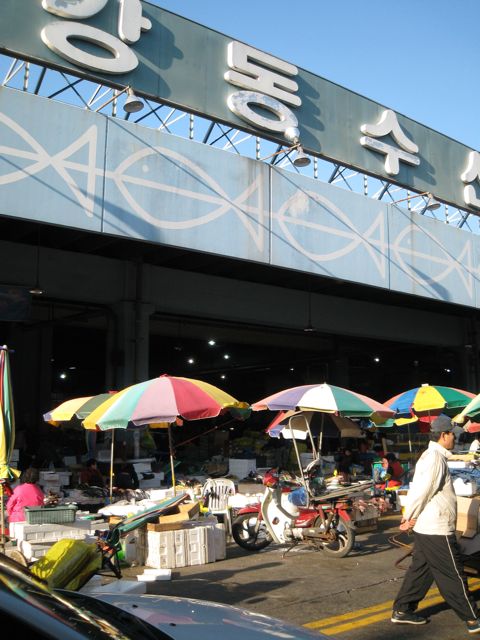
This place is big. It’s not Chatuchak big, but it’s big, and it’s all about food. Either killing and buying it, or else eating it.
Located on the South side of the Han, across the river from TechnoMart, it wasn’t that bad a drive on a Sunday afternoon. We just popped up the river, turned right, paid for parking, and pulled in. No real crowds, as this was the middle of the day, and the big wholesale rush was long over.
This was not the optimal way to do this. Really, for the full Garak sijang treatment, you need to show up around 1 or 3 in the morning, and be prepared for a lot of soju, and to come home smelling of fish guts and bile (either the fish’s or your own).
However, like I said, we were getting time conscious about things, and this needed doing.
So we were going to do lunch.
To the right of the entrance are the Halls of the Dead. And on the left you have produce. The right sounds much more dramatic, which is why I call it that. The Koreans probably just call it seafood, meat, etc.
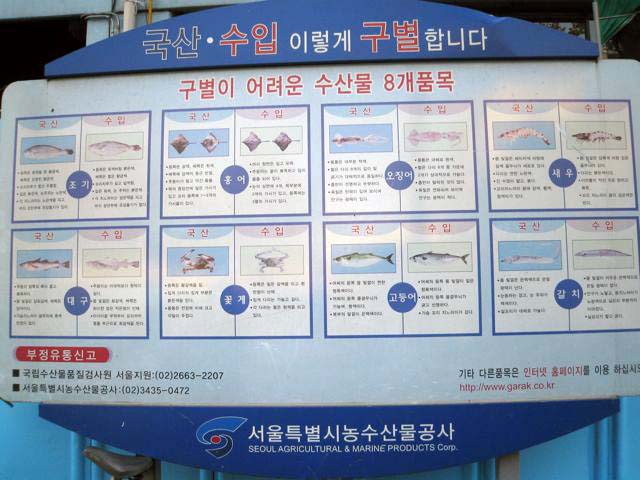
As you approach the seafood halls, there are big signs advising you on how to recognize local Korean products (gukhan) vs imported/foreign goods (su ib). On the left they would show a picture of the Korean product, and to the right they’d put up a description of the foreign.
Properly educated, we lit off into the belly of the beast.
This was great.
I should’ve worn boots.
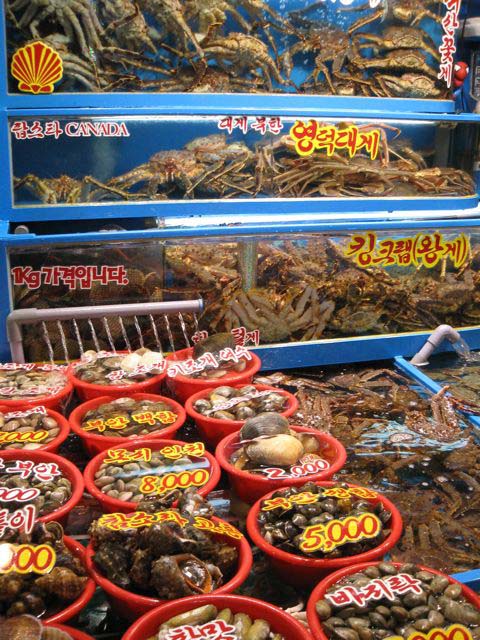
Crabs, clams, conches…..they’ve got it all. And you can either buy it for home…..or your restaurant, given that in Korea there’s probably a 1 in 10 chance you’re involved with one…I would ask repeatedly how many eateries there were in Korea, and people would just giggle.

There was no question of being fresh. Stuff was wriggling, flexing, crawling, flapping, and swimming. The only thing that wasn’t alive were the plates of fresh fish (hwae), and I’ve got a funny feeling that trying to pass of bad fish in this place wouldn’t be a wise move.
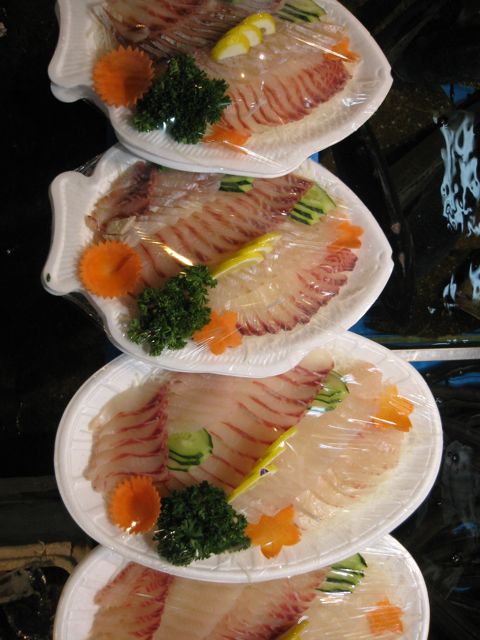
Fish packed on an attractive plastic plate, and securely saran’ed. A cheap snack, but they’d still taken the time to carve the vegetables to look good.
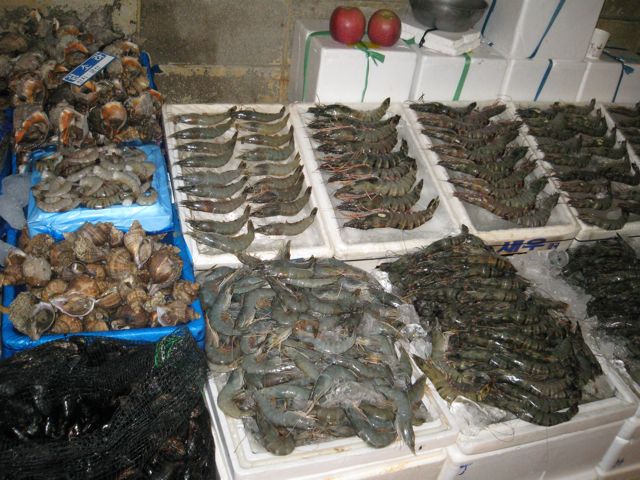
And plenty of prawns. At some point there’s a break over of what’s big and expensive enough to lay out tidy, and what’s going into a pile.
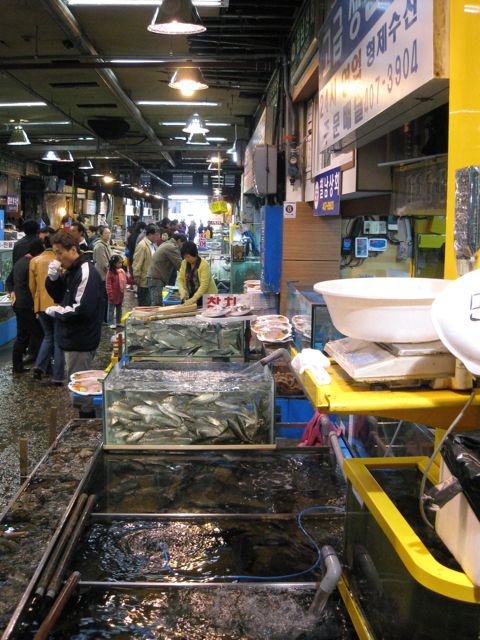
Did I say something about boots? It wasn’t really all that bad, you just had to be careful where you put your feet, especially if you almost trip over some muscular ajima beating a grouper to death with a stick (I’ve got that on video, not still).
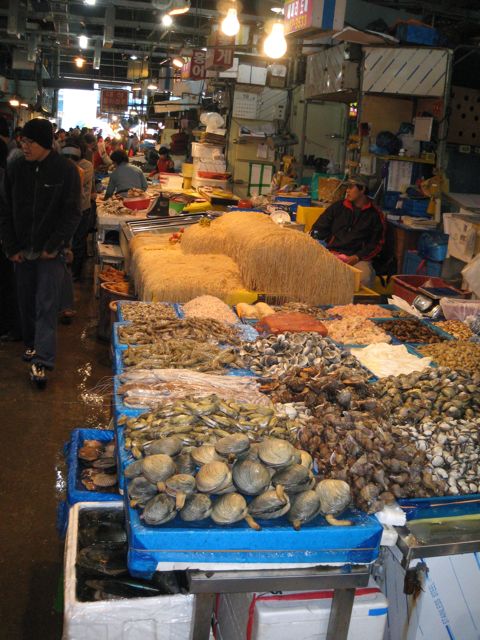
We were doing an initial recon for lunch. We figured we could take more time later on to check everything out. I was in a mood for clams, but not the really big ones. I wanted some shellfish of a more approachable size. There were big piles of jellyfish that looked like rocks at lowtide, covered in noodles,
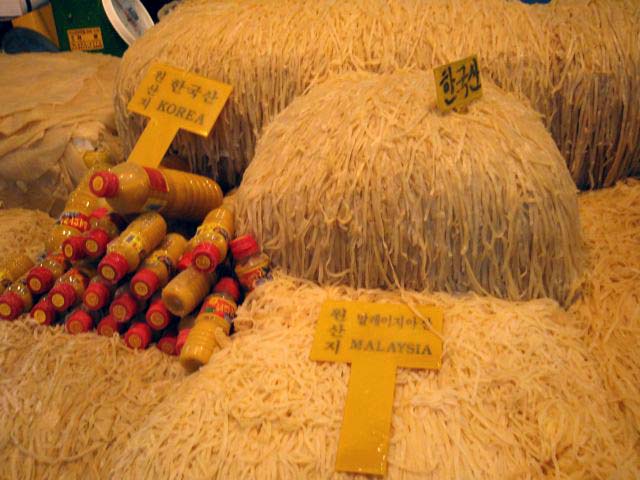
and there were plenty of mongke (the “toggebi” food I always refer to).
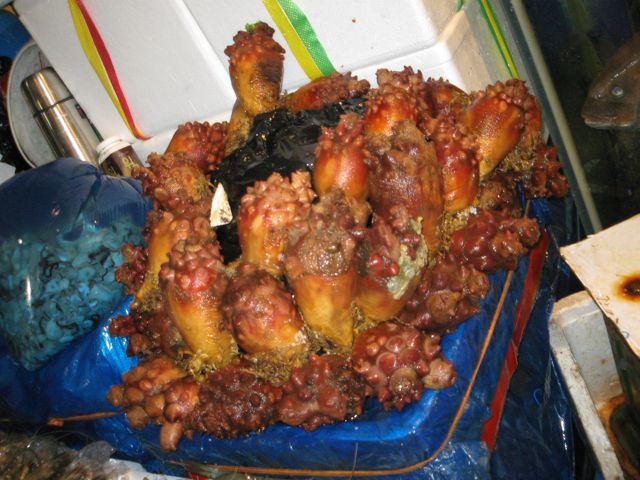
but I was keen on getting crab while we could (and I know Jason likes crab). So we started haggling with one of the vendors over the size of the crab we’d want. There’s a crossover point on size where they get more expensive. The bigger the critter, the more valuable it is…like diamonds, but easier to digest.
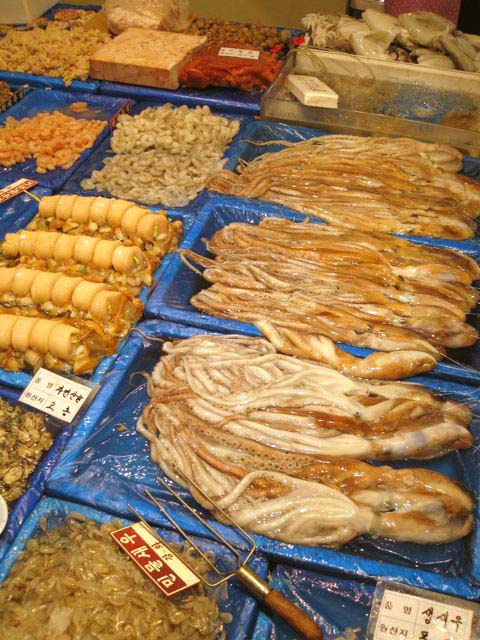
While Jason negotiated the crab deal, the octopus took my attention. There were two types, the one to be eaten in a stew (nakji bokkum) – luscious red dish (okay, what dish in Korea isn’t red?) with squirty soft chewy octopus; and the other type to be taken raw, or lightly boiled with gochujang.
Once we were loaded down with what we figured was enough stuff to eat for one sitting, we set off in search of the restaurant that would prepare this for us.
Next: The Restaurant That Would Prepare This For Us (what else were you expecting?)
-
hot dogs + bacon and chili? whoa....that would've gone great with all of your beers.
I think they'd've had me sleeping on the balcony for the rest of the trip.
Next: Shoppin'
-
October 19 – A Night At The Opera

(a non verbal opera)
Basic information on Cookin’ Nanta!
1) It’s really good. Excellent fun. Go see it . No brainer.
2) Expect to go through hell to get a ticket in Korea
We’d already sort of covered some of this earlier, the tickets that is.
We’d gone through several days of trying to get tickets, and finally had to resort to working through acquaintances. Thankfully, we had them.
The problem is that the theatre won’t sell tickets in advance except through the internet. (World’s most connected country). In order to make a purchase of anything on the internet, you must supply a credit card number and your citizenship number.
This is where it gets tough. As a tourist, you won’t have a citizen’s number.
So, get our nephew to get the tickets, you say?
Jason, as a gyopo, has most, but not all of the privileges of a Korean citizen. The “not all” part is kept track of through a different prefix on his number. That prefix doesn’t work with internet purchases.
So, when Yoonhi contacted the office by phone, the result was….frustrating. When they found out we weren’t Korean (it came as a shock to me, I tell you) they recommended that we have our tour guide book for us. When we told them we didn’t have a tour guide, they just hung up.
Oh well.
But there was a ticket office. We figured we could work with that. People, tickets, money….these concepts usually work well when in close proximity.
We’d showed up there a few days before. Nobody. Closed. Nada. Yoonhi had phoned them at that point, and found out that this office only did “extra ticket” sales an hour before the shows.
The bulk of the ticket sales go through tour groups, with block bookings. So there’s a pretty good chance that you can just show up and get a ticket to get in.
I don’t deal well with uncertainty.
Anyways, when we were there and we had our reservation. All that remained was for Jason and Yoonhi to pick up our family tickets from the now-open ticket booth (they issue the physical ticket at this point, once you’re there, then see if there’re spares they can sell).
The final barrier, which Yoonhi and Jason bulled their way through while I was admiring the lobby and the Nanta stuff on sale, was to convince the woman at the booth that we were a family (a 30% discount for a family of three or four). As it was, Yoonhi had to go through:
“Where’s your ID”
“What ID? I’m a tourist.”
“You’re supposed to bring ID to prove you’re a family!”
“It’s not here. It’s back home.”
“You don’t sound like a tourist.”
“But I am a tourist!”
“Well………:
I should’ve been there. White guys get away with anything.
But Yoonhi persevered. She always does.
So, for those that don’t know let’s talk about Cookin’ Nanta!
This is best described, by one of the critics, as “Jackie Chan Meets Benihana Meest the Marx Brothers”.
Do I need to say more?
Okay, okay! The show is a non-verbal slapstick comedy. A kitchen has to prepare a wedding banquet in one hour’s time, saddled with the restaurant manager’s nephew, who’s been added to the kitchen staff.
Okay, with the storyline out of the way, the essence of the show is percussion. Nanta means to “beat relentlessly”. Chopping, beating, hammering, drumming, and some good old stage fighting tossed in. If you’ve watched Korean (and/or Japanese) drum performances, then you’ve sort of got an idea. The finale is very much a traditional synchronized drum dance, but with kitchen tubs and water drums.
And they know how to handle an audience, to get them involved. At that point, even if you can’t understand Korean, it doesn’t matter. When the head chef, trying to get the clapping synchronized has to deal with one old lady in the audience who is always one beat behind, you feel his pain in that long, drawn out “ajimaaaaaaaaaaaa!”
The history of the show goes back to 1996, when it was first started up. Everyone was surprised when the show still kept going strong through the Asian Economic Crisis of 1997 (referred to as “IMF” in Korea). And since then they’ve been running for 10 years non-stop.
They have two theatres, one south near Apgujeong (which is where we went) and the other north, back up to the NorthWest behind Deoksugung Palace (near City Hall). Along with the two theatres, they’re also performing world-wide, with 35 countries covered so far.
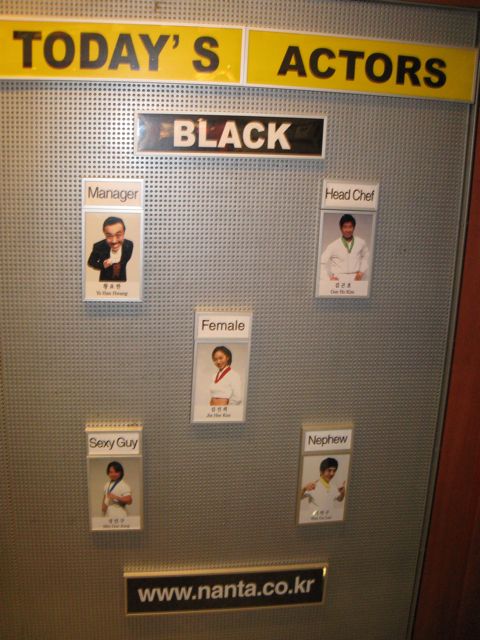
With this much work they run six teams. Black, blue, white, green, red, and purple. For tonight, we were watching the black team.
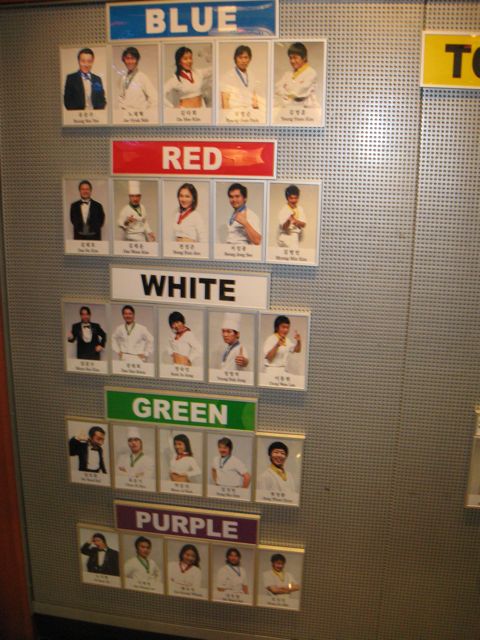
By far the best venue for them has been Japan. In an interview in The Groove (a local entertainment rag – www.mygrooveonline.com ) the Red Team had said that of all the stages, the one in Okinawa was the best, with a rear exit that opened on a beach. I wonder which stage that was?
They reckon that over 70% of their fan base is Japanese. Some of the Japanese fans are really hard core, having seen the show over a hundred times. One of these, when he was diagnosed with a serious illness, went so far as to transfer to a hospital in Seoul so he could catch the show regularly.
And we did hear a lot of Japanese about us. But we also heard a lot of Korean, too, so the show isn’t just a tourist draw (and if you pass your ticket stubs to your friends, they can get a 20% discount).
Success brings competition, so there’re a bunch of these shows now; Jump (more martial arts), Togebi Storm (again, martial arts percussion), and the Nanta people also have B-Boys. Hey, they’re packing the theatres.
And it’s a nice theatre. Not too big, so whichever seat you get, you’ll have a good view (and be in range of them throwing things at you). If you want to be part of the show, sit on the aisles.
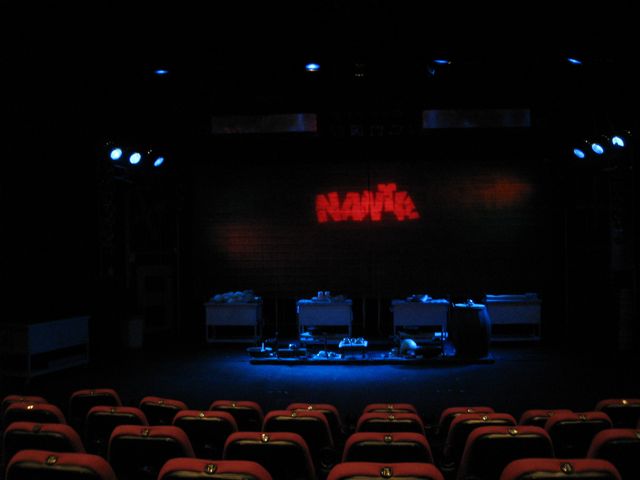
With the cast of five, they were flat out for a little over 90 minutes. Man, I’d be ded after ten minutes, and this crew kept on going and going like a pack of knife wielding Energizer bunnies.
We loved the knife work. The flash of steel and storms of cabbage, carrots sliced machine-gun style, cucumbers julienned in mid-air, and an onion tossed up and diced.
I wish I could do that, but Yoonhi won’t let me practice with Scud when he comes back to visit.
Maybe when she’s not around……..
After the show, well, we were in Apgujeong…..
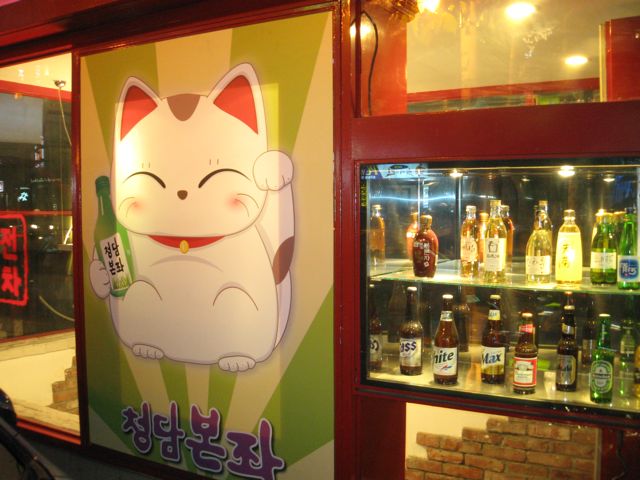
We toodled about for a little bit, taking in the bright lights. Jason talked a bit about the transient nature of business there. It’s the in, hip place to be, and you pay through the nose for rent for that reason.
It’s a good thing that cell phones were invented. It used to be that you’d meet at certain locations, like the McDonalds across from Galleria. But when we went by that block, everything had changed. Suddenly, people were without landmarks.
A lot of shops in this area only last for three or four months. Turn-over is that brutal. And some of the long lasting ones either get by on the reputation of being first (like Rock and Roll)
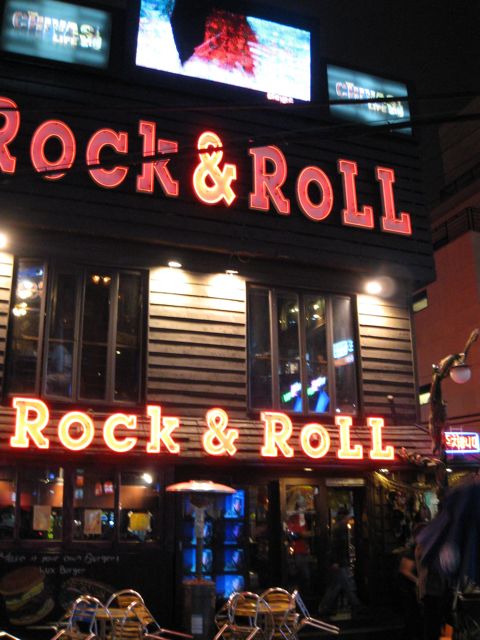
or by completely renovating every few months like AFS – Café Ahn - and putting on a new face to lure back old lovers (Korea is also the world leader in cosmetic surgery….but I won’t go there).
But, it’s a tribute to the trend-consciousness of Korea that people are quite willing to pay a 30% premium on their drinking and eating just to be where everyone is supposed to be.
Okay, maybe that doesn’t sound that much different than anywhere else.

I wish my appetite had been better (and my thirst less). I found bacon wrapped sausages with chili that just looked real, real good……..
One of the survivor establishments on my list that I wanted to visit was Platinum. This is a proper brew pub, stainless steel on display up at the front, very modern, none of this faux Brittania (or kleine Munchen) that a lot of places go in for.
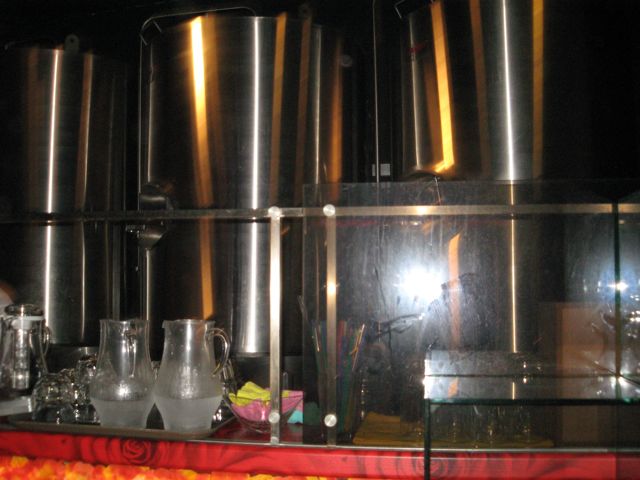
This is one of the first (if not the first) of the brew bars that sprouted up when the Korean government liberalized its brewing laws in 2002. Not many of them are still around. Jason remembers the early days here, when they only had one beer they could sell. The problem was that, while the laws were liberalized, they still had to license each beer individually on its own specs. Try doing that when you’re in start-up in a brewery! Every day’s another experiment that you have to give away for free because you’re not allowed to sell it.
Mind you, that can build up some customer loyalty.
Now they’ve settled on 7 beers:
Wheat beer 4.7% - typical German
Belgian White 5.1% - “it is a Belgian style wheat beer and has attractive orange and coriander flavours”
Platinum 4.5% - British style
Brown Ale 5.5% - this is self explanatory
Pilsner 4.7% - “it is a legitimate beer of Pilsen, the Czech Republic. The beer is made with czechish hof and is matured more than 50 days.”
Cream Stout 4.1% - ‘taste of Ireland”, using a nitrogen system.
Morphine 8.4% - “it has been brewed without any distillation process. We recommend that you can order this beer after enjoying other beers due to strong taste and high-proof.”
Okay, it looks good. It’s got history. But what’s the beer like?
Sorry.
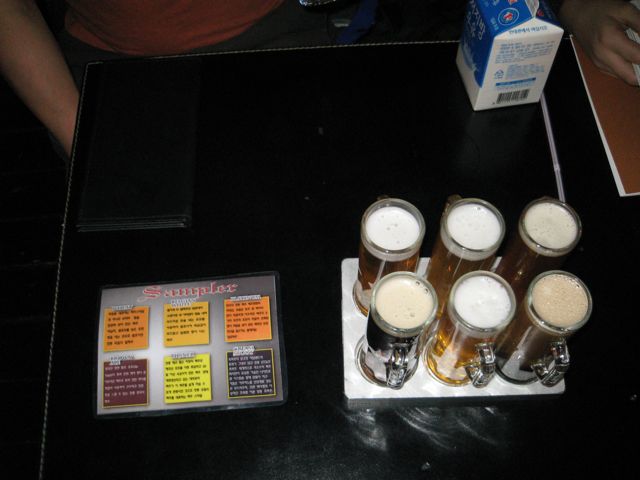
I did their taster set. Six beers in 120 ml glasses (not a bad serving). I honestly can’t say that I was that pleased with any of them. They were all weak on the finish, and they were overcompensating with aggressive hopping in all cases. I don’t mind a good hoppy IPA, heck, I’m almost tempted to fly back to Singapore for Brewerkz’ XIPA down at Clark Quay, but these were unbalanced, and reminded me of some spectacular failures I’d seen in Vancouver at the 2005 Caskival.
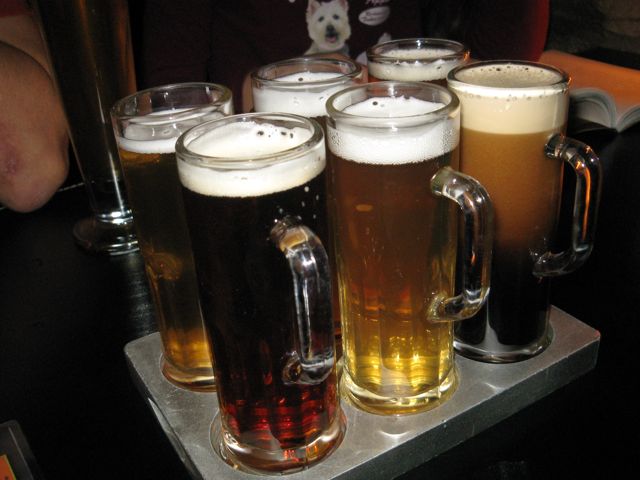
In position, from front right to front left are: brown ale, pilsner, cream stout. Behind them are, from left to right; wheat beer, Belgian White, Platinum.
Good heads in general, as you can see, and respectable bubblousity in the pils, but not one of them really succeeded at what they said they were trying for.
A major disappointment, too, was the lack of Morphine (or Morphone? I’m not certain which spelling they meant to use). At 8.4% this sounded interesting. Anytime someone refers to a beer as “high proof” I’ll pay attention.
Oh, well, you can’t have everything (but I’d sure like to try).
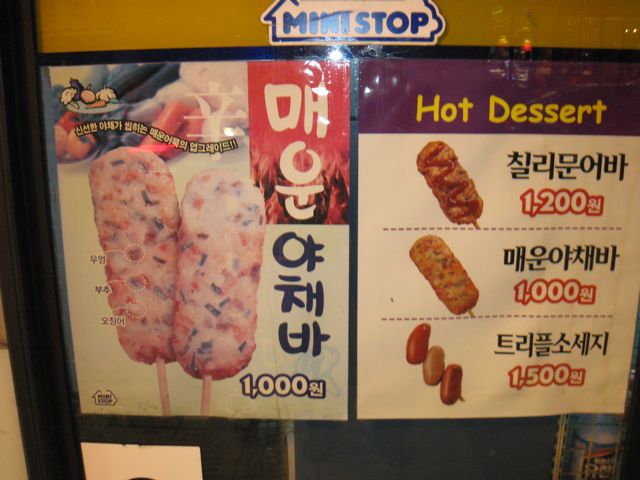
I thought about a hot dessert. The Mini Stop had these tasty sweets for finishing your meal; chili octopus bar, spicy vegetable bar, and triple sausage.
Who needs ice cream? (Serena, that’s who).
-
does serena like to dip the ddeok into anything? I used to like it dipped in soy sauce or gochujang and my grandfather loves it dipped in sugar. But he likes everything with sugar added

Nope, Serena's hardcore fundamentalist about her ddeok. She wants a stick of it in her fist, with no additives.
I don't try to make sense out of these things.
I watched this fantastic thing the other day on the local boston news. They do a documentary type news thing everyday and they have a short series called Future Boston. They feature cities around the world that boston should kind of strive to be. They other day they had on Seoul and it looked completely different. They supposedly have some of the best internet connectivity (?) in the world. It was pretty fascinating and its amazing how much korea changes over the years. Does korea change drastically for you everytime you and your family go?Korea's been the "most wired nation" now for a few years, and they've held that title. So, in terms of technology, when you go into people's homes you see those little pod robots scurrying about and all sorts of other neat stuff.
Plus, especially South of the Han, you're seeing new architecture that looks really sharp, as opposed to the Lego blocks I'd touched on before.
North of the Han, the current Mayor (who may be the next Pres) did a fantastic job of restorying an old creek and its environs into a water purification system that doubles as a Riverwalk. Very, very good looking, and a poster child for a lot of the efforts for making cities more liveable (we'll walk through it in another posting or two).
But what I still like is that, amidst all of the Brave New World stuff, when you lift the pretty skirts of these monuments to modernity, you find a swarm of the old Korea, of ryamen joints and bars and restaurants and people pushing food around on carts and.......well.....stuff.
I like stuff.
Darn! Now you've got me using up all of my material for the next posts!
Oh, and regarding the other "fellow employee"'s comments......we were eating around two bulbs of garlic a day.....And fermentation is the primary food prep method.....But, I dunno. Maybe I'm enured to the smells? I didn't find the smell of Seoul's Underground to be anything close to the Moscow Metro during summer. Now that was a pong!
But, if this guy's exposure was primarily Itaewon, I could see that it wouldn't make a great impression. As I mentioned, the Hill still looks like the Itaewon I remember from 15 years ago. You take that and compare it to the neighboring Yongsan base (which is why Itaewon is there), which is like a piece of white bread from the 1950's, and you'd probably make his conclusions.
Pity I didn't get onto Yongsan this trip. But they probably wouldn't have let me shoot pictures anyways. They're fussy that way.
Okay, I'm getting back to writing.
-
October 19 – Friday – Le Cordon Bleu
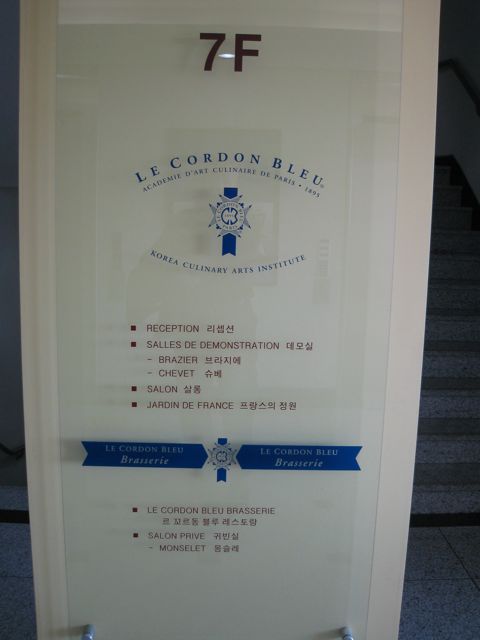
I’d called the day before to make an appointment with Le Cordon Bleu (LCB) in Korea. This is something I’d had in my mind since touring the new facility that has opened in Bangkok in cooperation with the Dusit Thani Hotel.
Here the faculty is set up with Sookmyung Women’s University, over near Yongsan. They’re on the 6th and 7th floors of the Social Education Building, and were quite willing to spare me some time.
I won’t go into a lot of detail here. For the greater part, this is because I want to give this material the attention it deserves, which is going to take more time. There are a lot of tie-overs between the Korean school and the new Bangkok school, as Mr. Young, who I spoke with, who has been a big part of the organization here, had been involved in setting up the Bangkok school.
To cover a few of the salient points, in addition to Le Cordon Bleu’s curriculum in cuisine patisserie, and bakery, they are also offering what they refer to as the Sabrina program, a series of one day courses for the public that touch upon many different aspects of cuisine, not just the strong French base that LCB focuses upon for its professionals. As a tourist, this appeals to me, with sessions touching upon Italian, Thai, kim chi and other topics, and I’m hoping that it’s something that Bangkok will emulate in one form or another.
They’d come into partnership with Sookmyung University through the efforts of Mrs. Lee, the President of the university. She’d been looking for ways to put a stamp of identity on this long-standing (over 100 years) institution. Their rival – Ehwa – had locked down many of the core subjects. President Lee had taken the plunge, and committed the university to being the cultural icon of the capital. This had worked well with Mssr. Cointreau’s plans to internationalize LCB beyond its traditional Paris and London schools (which he has done admirably, with schools in Canada, the US, Japan, Mexico, Australia, Brazil, and Peru).
I’ll come back to this material after I get the full Korea write-up done, and can devote the time to a coherent piece on what the LCB is doing in Korea and Thailand. You’ll just have to be patient.
Fitting back into the chronology, I’d left Yoonhi and Serena to their own devices in the neighborhood while I spent an hour and a half in the school. They’d used their time wisely, with Serena buying a Korean New York hot dog. Plain dog. No detailing, just ketsup. Especially no hot mustard. Yoonhi had gone in for ddeokboggi. Plain ddeokboggi No detailing, just gochujang.
The guy had massive tubs of ddeok and gochujang, which he was just dumping into the stainless steel metal trays. These were obviously industrial trays made for ddeokboggi joints, about 2 feet by 3 feet, a foot deep, and with a gas burner. They take their ddeokboggi seriously at the universities.
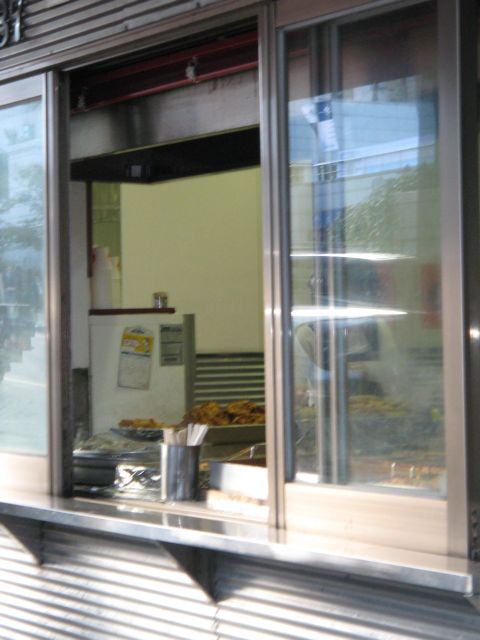
Serena liked her hot dog enough that she went back and got herself another one while her mom was eating ddeok. One of her first independent purchasing decisions.
Yoonhi did notice that a lot of the food joints had university students working in them. This seemed odd to Yoonhi, as it’s not the image she had of university life in Korea, of students working. Demonstrating yes, working no.
When I met up with the two of them, they had already been touring some of the museums in the university. I should rather say that they’d been touring the museum, as the galleries are all part of the Sookmyung Women’s University Museum, which is a collection of artifacts covering not just textiles (which is what I was interested in) but also sculpture, paintings, calligraphy, and ceramics.

The first gallery was dedicated to textiles, or rather costumes, and I was happy to wander around in there and look at the old Korean, Japanese, and Chinese textiles.
Downstairs was a collection of items related to women’s life, and was interesting enough, but lacked the colour of the costume gallery. But that’s a hard thing to compete with.

Also downstairs, which was a lot of fun,was the exhibition of the graduating students from Fine Arts. We hit it just as they finished the opening ceremonies, and were then almost tripped over as the young ladies raced in to stand by their exhibits as the groups came by to have everything explained, piece by piece.
Coming out of Sookmyung we worked our way down the hill, back towards the underground.
At the underground, the timing for this trip was further rubbed in my face by an add proclaiming that I would miss the 1st Chungmuro International Film Festival.
And the leaves will look so much better then, too.
I’d somehow neglected to eat anything, but contented myself with more pears when we arrived home.
We were taking an early dinner this evening, as we were to see a show. With this in mind, it made the most sense to eat close to the theatre, and close to the theatre meant Apgujeong. And Apgujeong meant that Jason had something he wanted us to try.
We ate at what I believe is called Seonbong Hwakrogui, up on the second floor. What we were having tonight was beef.

This time the beef wasn’t ribs, but a good cut of meat taken very, very thin. The cut was closer to what we’d eat at home – sogumgui style – but a little different, without the salt, pepper, and sesame.
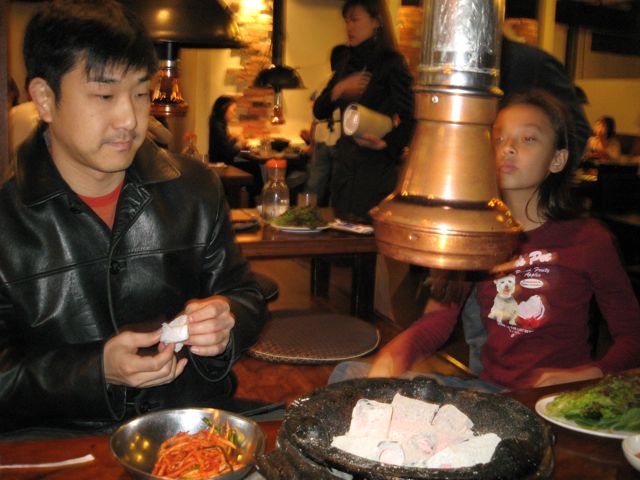
Charcoal grilling on the table, with clumps of white hot charcoal deposited and kept fresh. Likewise there’s the Dr. Who fume extractors. You pull these things down for the cooking.
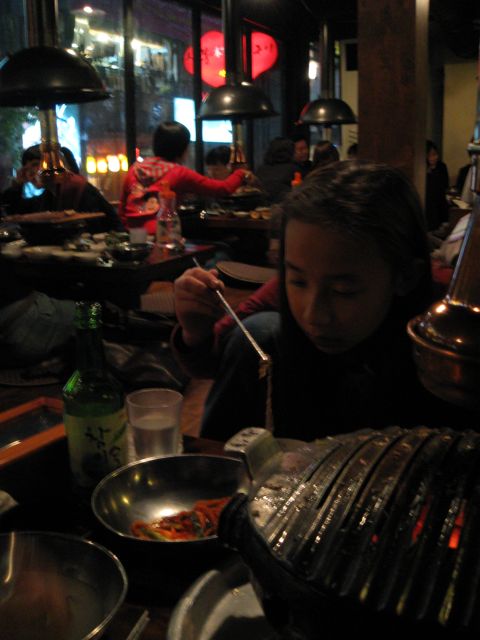
Meat this thin grilled in an instant, which is good, given that Serena was in serious carnivore mode and was snatching everything as it came off.
And the grills are kept clean. As fast as Serena would clear a grill of its meat, the staff would be by to transfer a new stove top in its place.
And as fast as I cleared a bottle of soju, another came in its place.
I think of it as a yin yang thing.

Our chigae was silky smooth tofu. I can’t quite put it coherently, but when you dip into a good communal pot of chigae, there’s a feeling of comfort, of being satisfied.
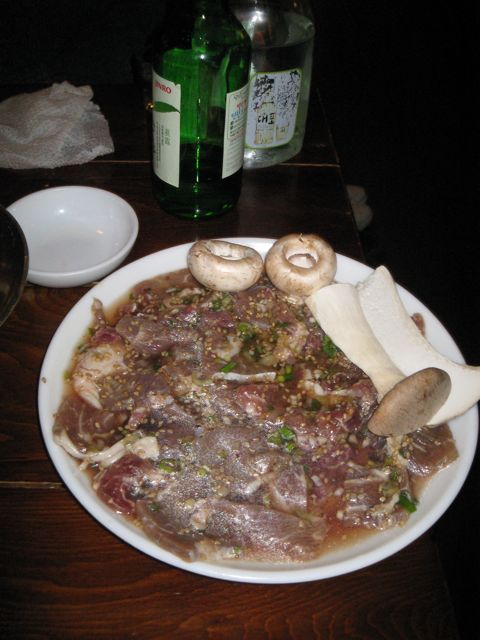
We ordered a plate of a thicker cut, wallowing in a wet marinade with more mushrooms, this time including some mushroom caps.
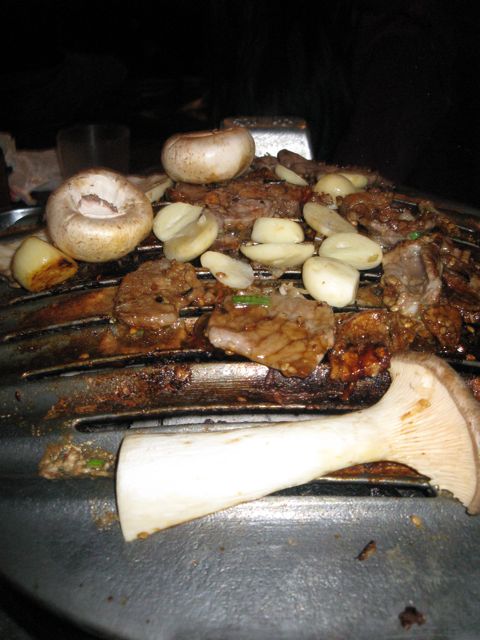
This all messed up another grill, but it was in a good cause. The mushroom caps you leave on the grill to give up their water, and then, when done, you quickly pop back the cap with the fluid.
I don’t think we have enough garlic in our diet.

The finisher was bibimnengmyun, cold, hairlike noodle, the egg, sauce, and vegetables all tidy and neat at the onset, and then a cold mess of flavour once the spoons and chopsticks have had their evil way.
We were fed, and it was early. We had plenty of time for the next part.
Next: Nanta!
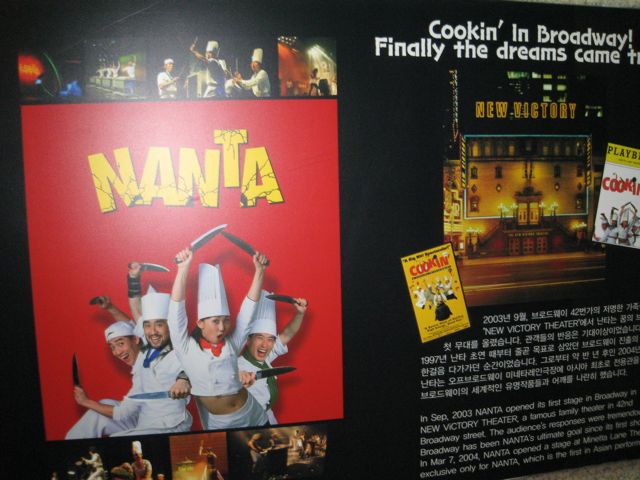
-
Bits and Pieces
I'd bugged Jason about the "nori" in "Nori People" the place we went for yogurt soju shots (which then had its fallout the next morning). Nori refers to play, giving the idea of playful people.
When they talk about cheese in most of Korea, they're talking processed cheese. Think Velveeta.
Having said that, good cheese did start showing up in Seoul a few years ago, and Jason credits this in part with the rise of the wine culture. It strikes you now. When you go through the malls you see wine shops all over the place, and when you're in the hipper districts (and Itaewon) you see more and more wine bars. This just wasn't here ten years ago.
Driving standards. Any trip in a car anywhere in Seoul is going to involve one U-turn (ideally on a major 8 line street) and one stretch in reverse in an alley. You just can't avoid this.
Okay, those are just some things I wanted to get off my chest. I'll get back to the regular write-ups now.
-
A Hole In The Ground
It was one of those distances and locations where you couldn’t do it on public transit, and you probably had no chance of explaining to a taxi where you were going.
So you just drive.
Anyways, we’d found the car.
Just as last night’s spot was, literally, a hole in the wall, this was a subterranean den, a hole in the ground.
It seated about 30 (bigger than last night) but it wasn’t bigger by much. Shoes off, sit on the floor, and tables on either side.
The restaurant went by the name of mujijang meun galbi ondoljib charimsang[/b[ what that translates out as is Incredibly Spicy Rib Heated Floor House Prepared Table
C’mon, say that five times fast.
The place had a pedigree. I was learning to recognize this. The stock photo of the two tv anchors, the signed bits and pieces, stuck up there.

The streetfront was a staircase, which you descended to get to the small entryway where you doffed your shoes before coming onto the ondol.
We took a table near the front to be close to the food, and ordered away.
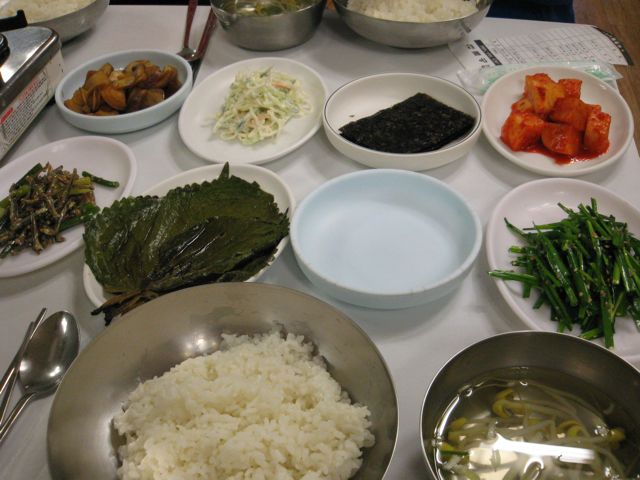
The panchan was good enough. Some things were a little different from what we’d been having normally. The gaenip was marinated, like what we’d have in cans back in North America (but this hadn’t been canned). And there was a lovely little pile of fresh chives, and a bowl of broth with kunnamul in it, the big bean sprouts like eels in the liquid.
And we had white rice. It seems odd, but we’d had very little white rice during the trip. Lots of bokkum bap and bibimbap, but, outside of eating with Doddie in Icheon (in a town reknown for their rice), and the truck stop (where they’d added in millet), I couldn’t remember a simple bowl of white rice on the table.
But then again, I’m getting old.

They do one dish, and that’s it. Beef ribs boiled in a spicy broth. Your choice is in how spicy you want that one dish.
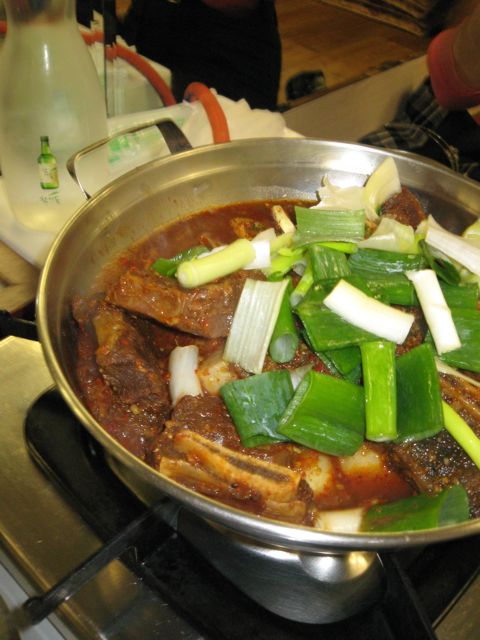
You can order it medium; hot; very hot; or super hot. Yoonhi put her foot down, and told us we could have it hot, but we weren’t going above that.
I breathed a sigh of relief.
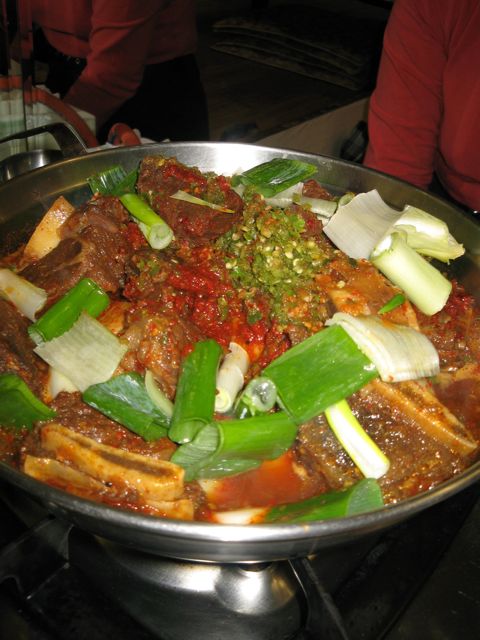
The dish just looked evil. The bright green leeks couldn’t disguise the dollops of chili that were resting there on top of the dish. All of that was going to work it’s way into the meat and broth.
The meat had been marinated in the spice, and then partially cooked. The idea now was to bring everything together in the table-top boil – ribs, leeks, chilis, more chilis, still more chilis, and some potatoes that were submerged under there somewhere.
We considered washing some of the meat early for Serena, but it was already too hot. Serena would be eating panchan, the rice and gim in particular (and we’d brought along some milk for her from a corner store).
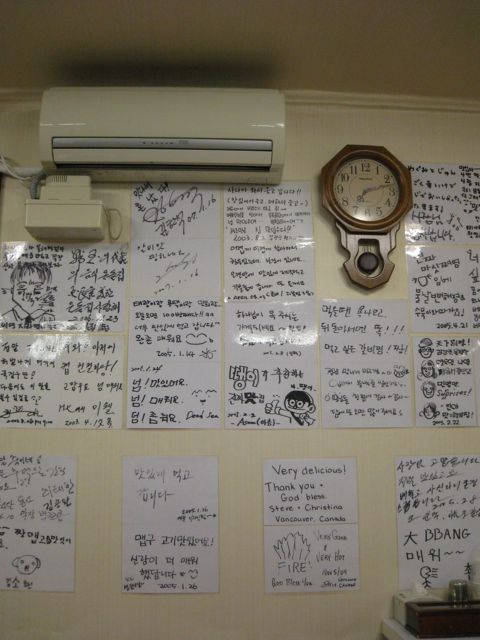
As with the outside notes, there was plenty of fan wrting, including some notes from Vancouver, even.
The “hot” was hot enough. I saw now why the rice was there, as you needed something to help sop up the burn in your mouth.
At the table across from us we heard one of the girls on her cell taking an order from her friends.
“No, no! You should order the super hot…….No, it’s not too bad!......Okay, we’ll order that for you for when you get here.”
Some people are just plain mean.

With the rice, Jason and I were coping. Yoonhi had been washing her meat in her kunnamul broth (sensible woman), and her broth was an angry shade of red.

The sauce had thickened up, with starch lent from the potatoes that had been lurking in there. At this point we wimped out, and we ordered another bowl, but this one medium, knowing that it would be building on the sauce already in there.
Loud slurps and expressions of delight were coming from all around us, so I guess the super hot was too out of control. Alternatively, they just weren’t going to admit defeat. Jason did point out that Korean women seem to be able to take food a lot spicier than men.
Maybe there’s hope for Serena? (To be fair, Scud was the same way. Tolerance for the burn seems to be something that comes with puberty).
The restaurant had an offer up on the wall: ”If you come with your mother-in-law, you get one free serving” (the Korean wording is such that this only applies to guys – “wife’s mother” for mother-in-law)
As expected, there was plenty of soju, and some beer. But I’m finding soju works best with the meats here, cleaning the mouth up more effectively.
Dinner finished we unfolded ourselves from the toasty floor, and climbed back to the surface. Serena had been well behaved, so it was time to search the local ice cream chests.
We turned up one of her “Rich Bars” that she liked, and Yoonhi found
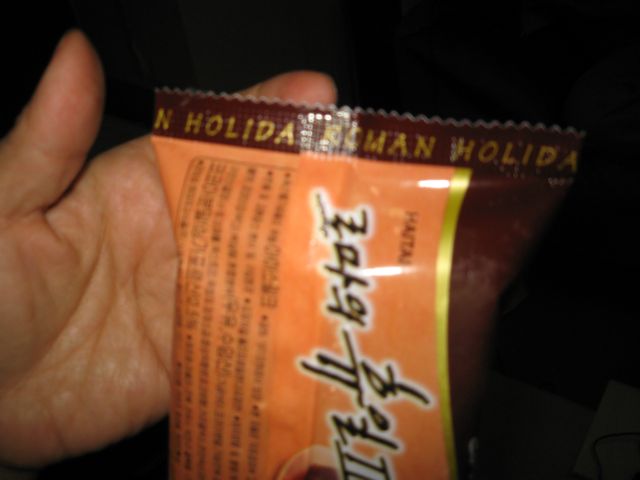
Roman Holiday II. What kind of a name is “Roman Holiday II” for an ice cream bar? And was there a Roman Holiday I bar at some time in the past? There was a picture of the Trevi Fountain, so we knew what they were thinking, kind of….maybe……(it wasn’t very good. Lots of faux chocolate and a sponge layer).
It was going to be an early night.
We needed it.
Next: The Blue Ribbon
-
Hiroyuki,
You need never consider it a mistake to start eating before taking pictures. Enthusiasm cancels all sins.
I do like the comments on the white fish. Being from Vancouver, I appreciate that I've been too obsessed by the stronger, oilier fish and shellfish, and my taste has been highjacked by these muscular brutes.
I found the sashimi (hwae) we had from the East Sea (Sea of Japan) had a beautiul, ethereal flavour, and, as it was on it's own as we ate, quite interesting.
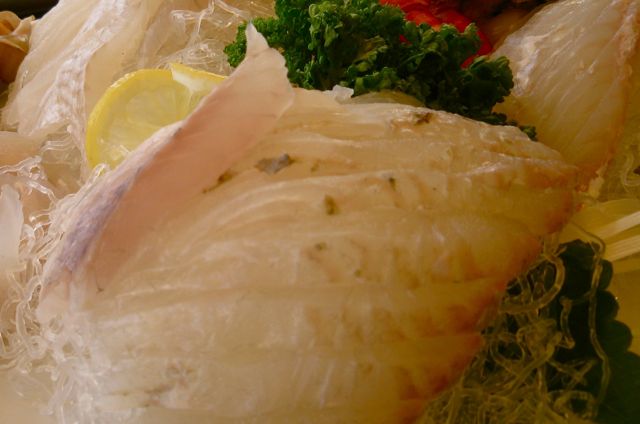
Did the chef say anything about the size of fish? I'd been hearing that there's much to be said for smaller fish.
Cheers,
Peter
-
Thursday, October 18 – Quite Ugly One Morning
I found the car keys in my jacket pocket. For a horrified moment, I thought maybe that I’d driven home. But then I remembered that I’d been given the keys to pass to Jason.
That was a relief.
Serena woke up happy, and was in even better form when we broke out some pears to get us started. Serena, Scud, Yoonhi, Jason, I and, I suspect, everybody with an once of happiness in them, loves these pears (I’m not being to encompassing, I hope?).
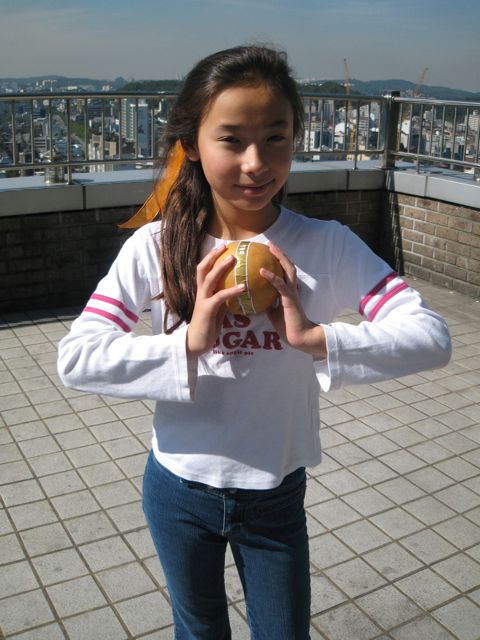
The only concern is that with Korean pears, you get awfully close to that “should you eat something bigger than your head” rule.
We’d promised Serena we’d take her back to the Coex Mall. She’d been enthralled by the interactive games they’d had there, and by the fact that there was a video arcade (oraksil). She’d tolerated our antics the night before, so it was only fair that she get some time.
Yoonhi was, shall we say, delicate.
With this in mind, once we’d arrived at Coex, our first duty was to get her sitting down, and with food in front of her.

I wasn’t going to be too fussy. We entered the food court, parked her, and Serena and I went out to find stuff. That wasn’t a problem. There were plenty of noodles, a juk (porridge) place, ramyun vendors, grilled anything, coffee, pizza, Italian, and an Indian joint. What you’d expect from a food floor.
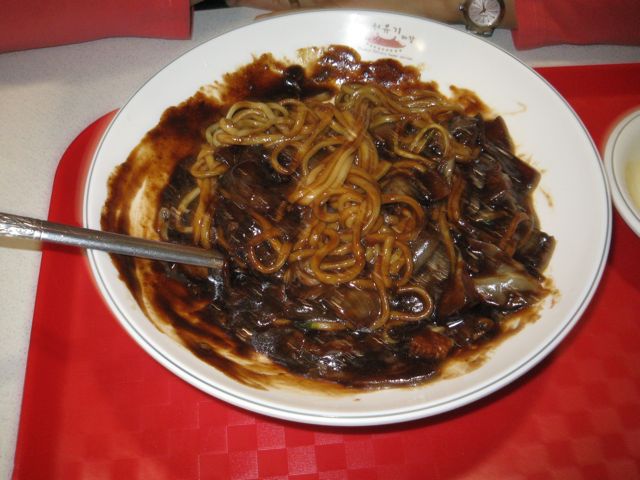
The obvious thing for Yoonhi was jyajeongmyun. I got her an order of this, and some Coke to get her sugar levels back to normal. Sticky noodles, with a stickier starchy black bean sauce.
Serena had an absolutely vile lasagna, with something that was supposed to be garlic bread. Mind you, what I wasn’t interested in touching, she was quite content with.
While Yoonhi repented her past night’s indulgences, I took Serena and scouted out what we needed to find. As I did so, I took more note of what was in Coex.
For instance there was the Jumanji Board Game café – a concept of “let’s go somewhere for coffee or milk shakes and play board games”. Not a bad idea, but do you sell enough stuff to cover your costs?
While I’m certain it has a Gallic charm to the ears, Le Crapeau seems like an unfortunate name to assign to an eatery.
And 7-11, in addition to their slurpees, is also selling steamed buns and odaeng.
Mr. Pizza is advertising their new Hancho Gold pizza, with squid and sour cream topping.
That got me looking. I just went to Mr Pizza's web page and found
Grand prix
(shrimp+potato)
surprising combination of European cookies and pizza!
Sprinkling the crust rings with sunflower seeds,
pumpkin seeds, and raisons,
this one-of-a kind pizza which tastes like
European soft cookies, will have you craving for
more! And that's not all. With Grandprix,
you can have our two best toppings,
shrimp and potato, on one crust.
And when you're done, dip the rest of the crust
into our irresistible blueberry sauce for dessert!
Now I feel bad I didn’t have enough time for Mr. Pizza! It’s on the list for when I go back.
Serena and I dropped in on the Bandi & Luni’s (I hope that’s the right spelling. Every web site has a different spelling) and found volumes two and three of the Cat School series (translated from the Korean), so I added these to the bribe-your-child account.
After about an hour, Yoonhi was okay to move. We took the girl to the oraksil, where she found, among all the bells, klaxons, and explosions, that she just wanted to play air hockey with me. This would’ve been a good father-daughter bonding sort of thing, if it wasn’t for the bells, klaxons, and explosions.
We’d thought of taking in a film. Like Thailand, Korea is extremely sensible about movies, both in terms of price and comfort. But, looking over what was being shown, we had the usual family problem of either nothing being appropriate, or nothing being in English (that we wanted to see).
We headed back for the underground, Serena now satisfied. But, as we came up into the exhibition hall, we saw two signs.
Sign #1: Toy Expo
Sign #2: Robot Expo
Okay, I screwed up. I went to Robot Explo first, as it was on the ground floor.

It’s not that this was that big a mistake in terms of what we saw. The robots, covering manufacturing, security (I liked the one with the belt fed machine gun), firefighting, bomb disposal, cleaning (there were four different pod-like autonomous vacuum cleaners), and just plain toys were interesting for all of us.
Yoonhi, along with a horde of others, lined up and spent her time in the massage chair, which I would hardly say qualifies as a “robot”.
No, where I messed up was in that, by the time we’d spent another 90 minutes in there, we’d pretty much exhausted ourselves for the morning, and the toy exhibit had to go by the wayside (but Doddie covered it! Billy lucks out!). We took our sorry selves onto the underground, and bullied our way onto seats so we could rest our feet for the trip home.
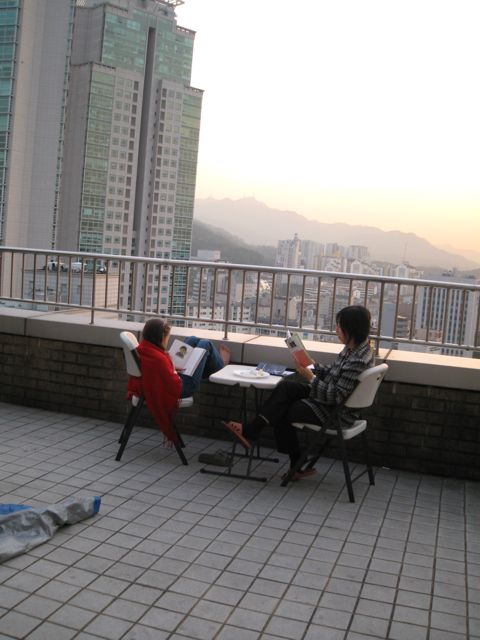
Yoonhi was starting to feel normal again, so we had a quiet afternoon on the balcony. Pears, with their clear, sweet juice and crisp taste, seemed like the thing to have.
I do miss Korean pears, and having them available, it just seemed appropriate to eat them at every opportunity.
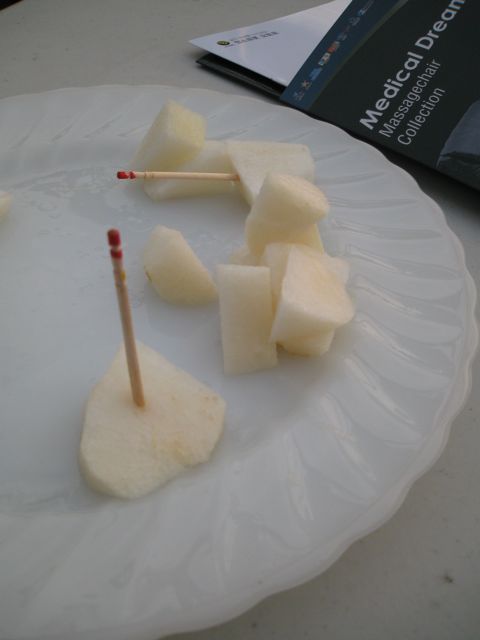
Jason arrived home in the early evening, and we had another concern.
Where was the car?
I figured we were doing pretty well knowing where the keys were, but if we wanted to get the dinner in for this evening that we’d planned, we were actually going to need to be able to put the keys together with the actual automobile.
There’s an episode of Seinfeld I recall, where they’ve parked the car somewhere at a new mall, and the show revolves around the long, long search for the vehicle.
Luckily, the parking lot only has 3 floors of general parking, and after that there’s “the thing”. The thing is a robotic system which will take your car like a cake into an oven, and descend with it to the lower depths, where it’ll be offloaded into a slot. You get a code for your place in “the thing”. You need to remember your code.
We tried to avoid “the thing”.
We were pretty certain we hadn’t parked there.
Given three floors of parking, we figured the search was manageable.
“I think we parked on the first level,” said Yoonhi.
“There’s never any space on first. Let’s start at two.”
You know where this is going. It was on first, which we checked last, walking about clicking the car keys at random trying to hear a “snick”.
It was dark by now, and we were hungry. Last night we’d done a true “hole in the wall”. This night it was going to be something completely different.
Note: edited to make it easier to find Mr. Pizza - 'cause you need to know!



Korea - Land of the Morning Calm
in Elsewhere in Asia/Pacific: Cooking & Baking
Posted
I'll check with Yoonhi, but a better source will show up in a couple of more days. Some of our old friends moved back here (just up the hill) a few months ago, and she's much more Korean than Yoonhi. She's getting back from Seoul this weekend, I think, so I'm going to bug her (she arrived the day we left).
Hosting a dinner for 5,000 won........I'd blow that just on pears for dessert!
Cheers,
peter